Leadership Styles and Theories of Steve Jobs
VerifiedAdded on 2021/04/05
|20
|5787
|67
AI Summary
This assignment provides an in-depth analysis of the leadership style and theories of Steve Jobs. It includes quotes from Steve Jobs himself, as well as references to various articles and books that discuss his leadership approach. The assignment explores how Steve Jobs' vision-driven leadership empowered his team to develop innovative ideas and products. It also examines the importance of vision in leadership, employee empowerment, and innovation leadership. The summary provides a detailed overview of the assignment's content and themes.
Contribute Materials
Your contribution can guide someone’s learning journey. Share your
documents today.

Leadership in action
ASSIGNMENT
Course Title
Business
Management
Acumen Program
Student Name Sureshkumar prediksha
Unit No. &Title Unit 23: Leadership
in Action Pearson No.
Semester/Batch
No. B-Mac 15 Centre Ref. No 1018426
Learning
Outcomes
LO1, LO2, LO3 &
LO4
Student’s Contact
No. 0768104301
Assignment Title Leadership in Organization
Assessor Jayani
Hewavitharana
Issued
Date 06.04.2020 Submissi
on Date
T1- 25 May
2020
T2- 14 June
2020
Assessment Feedback
Criteria Comments Achievement
(Y / N)
PASSMERITDISTINCTION
General Comments
Final Grade
Awarded Assessor Signature: Date:
IV Signature: Date:
Student Agreement: I understand the feedback given to me and agree to carry out the
actions in future works as required and indicated.
Student Signature: Date:
ASSIGNMENT
Course Title
Business
Management
Acumen Program
Student Name Sureshkumar prediksha
Unit No. &Title Unit 23: Leadership
in Action Pearson No.
Semester/Batch
No. B-Mac 15 Centre Ref. No 1018426
Learning
Outcomes
LO1, LO2, LO3 &
LO4
Student’s Contact
No. 0768104301
Assignment Title Leadership in Organization
Assessor Jayani
Hewavitharana
Issued
Date 06.04.2020 Submissi
on Date
T1- 25 May
2020
T2- 14 June
2020
Assessment Feedback
Criteria Comments Achievement
(Y / N)
PASSMERITDISTINCTION
General Comments
Final Grade
Awarded Assessor Signature: Date:
IV Signature: Date:
Student Agreement: I understand the feedback given to me and agree to carry out the
actions in future works as required and indicated.
Student Signature: Date:
Secure Best Marks with AI Grader
Need help grading? Try our AI Grader for instant feedback on your assignments.
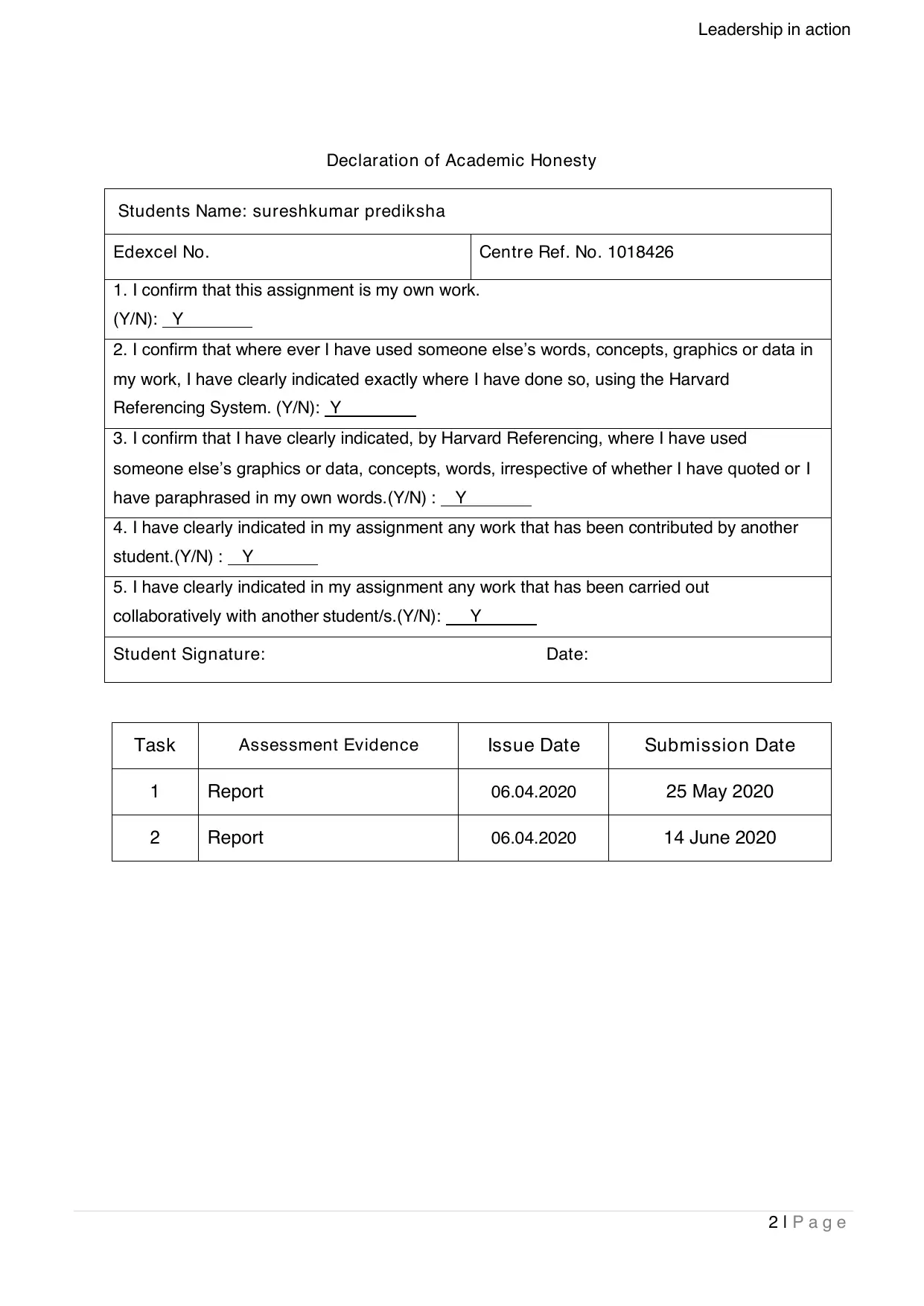
Leadership in action
2 | P a g e
Declaration of Academic Honesty
Students Name: sureshkumar prediksha
Edexcel No. Centre Ref. No. 1018426
1. I confirm that this assignment is my own work.
(Y/N): Y
2. I confirm that where ever I have used someone else’s words, concepts, graphics or data in
my work, I have clearly indicated exactly where I have done so, using the Harvard
Referencing System. (Y/N): Y
3. I confirm that I have clearly indicated, by Harvard Referencing, where I have used
someone else’s graphics or data, concepts, words, irrespective of whether I have quoted or I
have paraphrased in my own words.(Y/N) : Y
4. I have clearly indicated in my assignment any work that has been contributed by another
student.(Y/N) : Y
5. I have clearly indicated in my assignment any work that has been carried out
collaboratively with another student/s.(Y/N): Y
Student Signature: Date:
Task Assessment Evidence Issue Date Submission Date
1 Report 06.04.2020 25 May 2020
2 Report 06.04.2020 14 June 2020
2 | P a g e
Declaration of Academic Honesty
Students Name: sureshkumar prediksha
Edexcel No. Centre Ref. No. 1018426
1. I confirm that this assignment is my own work.
(Y/N): Y
2. I confirm that where ever I have used someone else’s words, concepts, graphics or data in
my work, I have clearly indicated exactly where I have done so, using the Harvard
Referencing System. (Y/N): Y
3. I confirm that I have clearly indicated, by Harvard Referencing, where I have used
someone else’s graphics or data, concepts, words, irrespective of whether I have quoted or I
have paraphrased in my own words.(Y/N) : Y
4. I have clearly indicated in my assignment any work that has been contributed by another
student.(Y/N) : Y
5. I have clearly indicated in my assignment any work that has been carried out
collaboratively with another student/s.(Y/N): Y
Student Signature: Date:
Task Assessment Evidence Issue Date Submission Date
1 Report 06.04.2020 25 May 2020
2 Report 06.04.2020 14 June 2020
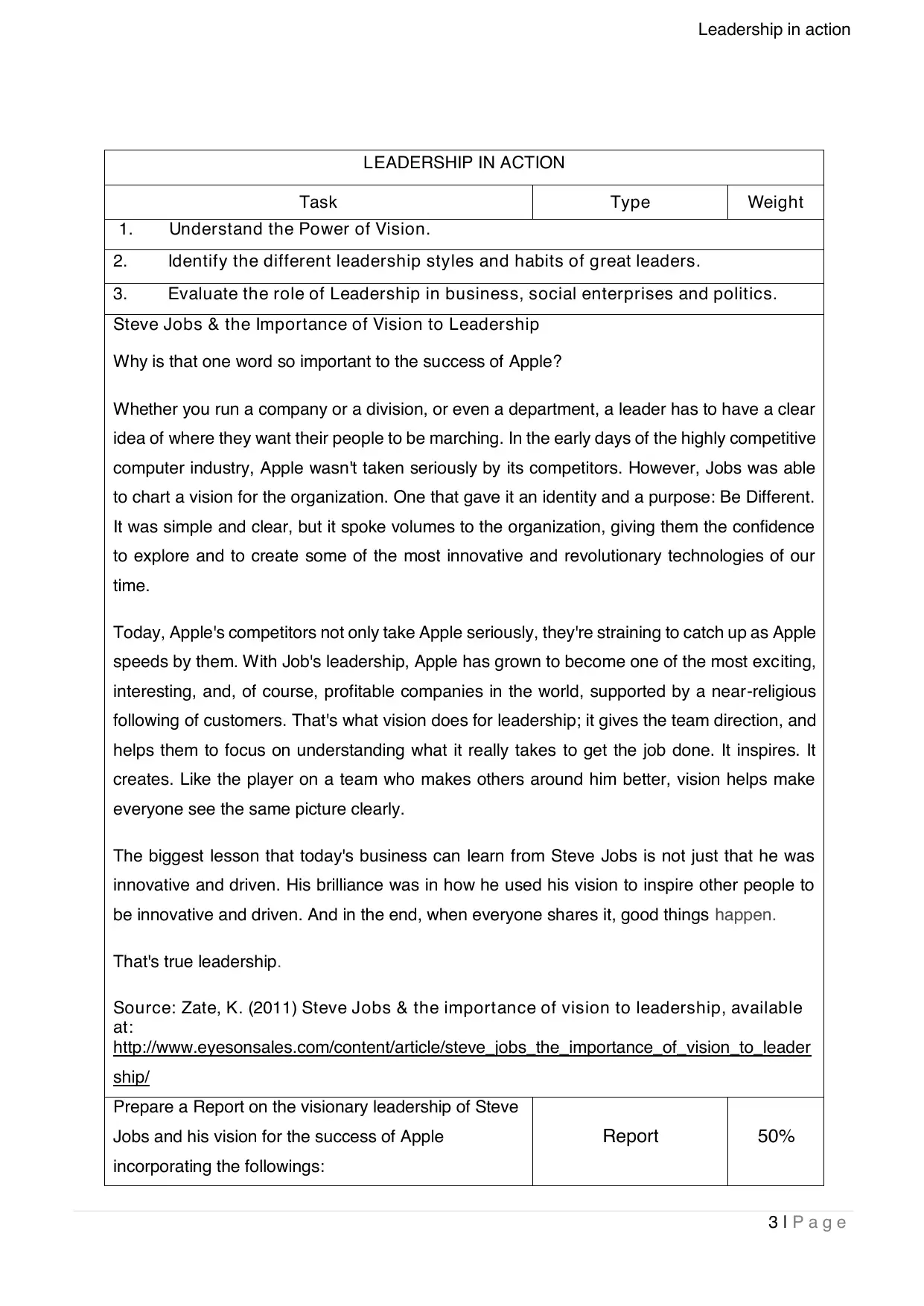
Leadership in action
3 | P a g e
LEADERSHIP IN ACTION
Task Type Weight
1. Understand the Power of Vision.
2. Identify the different leadership styles and habits of great leaders.
3. Evaluate the role of Leadership in business, social enterprises and politics.
Steve Jobs & the Importance of Vision to Leadership
Why is that one word so important to the success of Apple?
Whether you run a company or a division, or even a department, a leader has to have a clear
idea of where they want their people to be marching. In the early days of the highly competitive
computer industry, Apple wasn't taken seriously by its competitors. However, Jobs was able
to chart a vision for the organization. One that gave it an identity and a purpose: Be Different.
It was simple and clear, but it spoke volumes to the organization, giving them the confidence
to explore and to create some of the most innovative and revolutionary technologies of our
time.
Today, Apple's competitors not only take Apple seriously, they're straining to catch up as Apple
speeds by them. With Job's leadership, Apple has grown to become one of the most exciting,
interesting, and, of course, profitable companies in the world, supported by a near-religious
following of customers. That's what vision does for leadership; it gives the team direction, and
helps them to focus on understanding what it really takes to get the job done. It inspires. It
creates. Like the player on a team who makes others around him better, vision helps make
everyone see the same picture clearly.
The biggest lesson that today's business can learn from Steve Jobs is not just that he was
innovative and driven. His brilliance was in how he used his vision to inspire other people to
be innovative and driven. And in the end, when everyone shares it, good things happen.
That's true leadership.
Source: Zate, K. (2011) Steve Jobs & the importance of vision to leadership, available
at:
http://www.eyesonsales.com/content/article/steve_jobs_the_importance_of_vision_to_leader
ship/
Prepare a Report on the visionary leadership of Steve
Jobs and his vision for the success of Apple
incorporating the followings:
Report 50%
3 | P a g e
LEADERSHIP IN ACTION
Task Type Weight
1. Understand the Power of Vision.
2. Identify the different leadership styles and habits of great leaders.
3. Evaluate the role of Leadership in business, social enterprises and politics.
Steve Jobs & the Importance of Vision to Leadership
Why is that one word so important to the success of Apple?
Whether you run a company or a division, or even a department, a leader has to have a clear
idea of where they want their people to be marching. In the early days of the highly competitive
computer industry, Apple wasn't taken seriously by its competitors. However, Jobs was able
to chart a vision for the organization. One that gave it an identity and a purpose: Be Different.
It was simple and clear, but it spoke volumes to the organization, giving them the confidence
to explore and to create some of the most innovative and revolutionary technologies of our
time.
Today, Apple's competitors not only take Apple seriously, they're straining to catch up as Apple
speeds by them. With Job's leadership, Apple has grown to become one of the most exciting,
interesting, and, of course, profitable companies in the world, supported by a near-religious
following of customers. That's what vision does for leadership; it gives the team direction, and
helps them to focus on understanding what it really takes to get the job done. It inspires. It
creates. Like the player on a team who makes others around him better, vision helps make
everyone see the same picture clearly.
The biggest lesson that today's business can learn from Steve Jobs is not just that he was
innovative and driven. His brilliance was in how he used his vision to inspire other people to
be innovative and driven. And in the end, when everyone shares it, good things happen.
That's true leadership.
Source: Zate, K. (2011) Steve Jobs & the importance of vision to leadership, available
at:
http://www.eyesonsales.com/content/article/steve_jobs_the_importance_of_vision_to_leader
ship/
Prepare a Report on the visionary leadership of Steve
Jobs and his vision for the success of Apple
incorporating the followings:
Report 50%
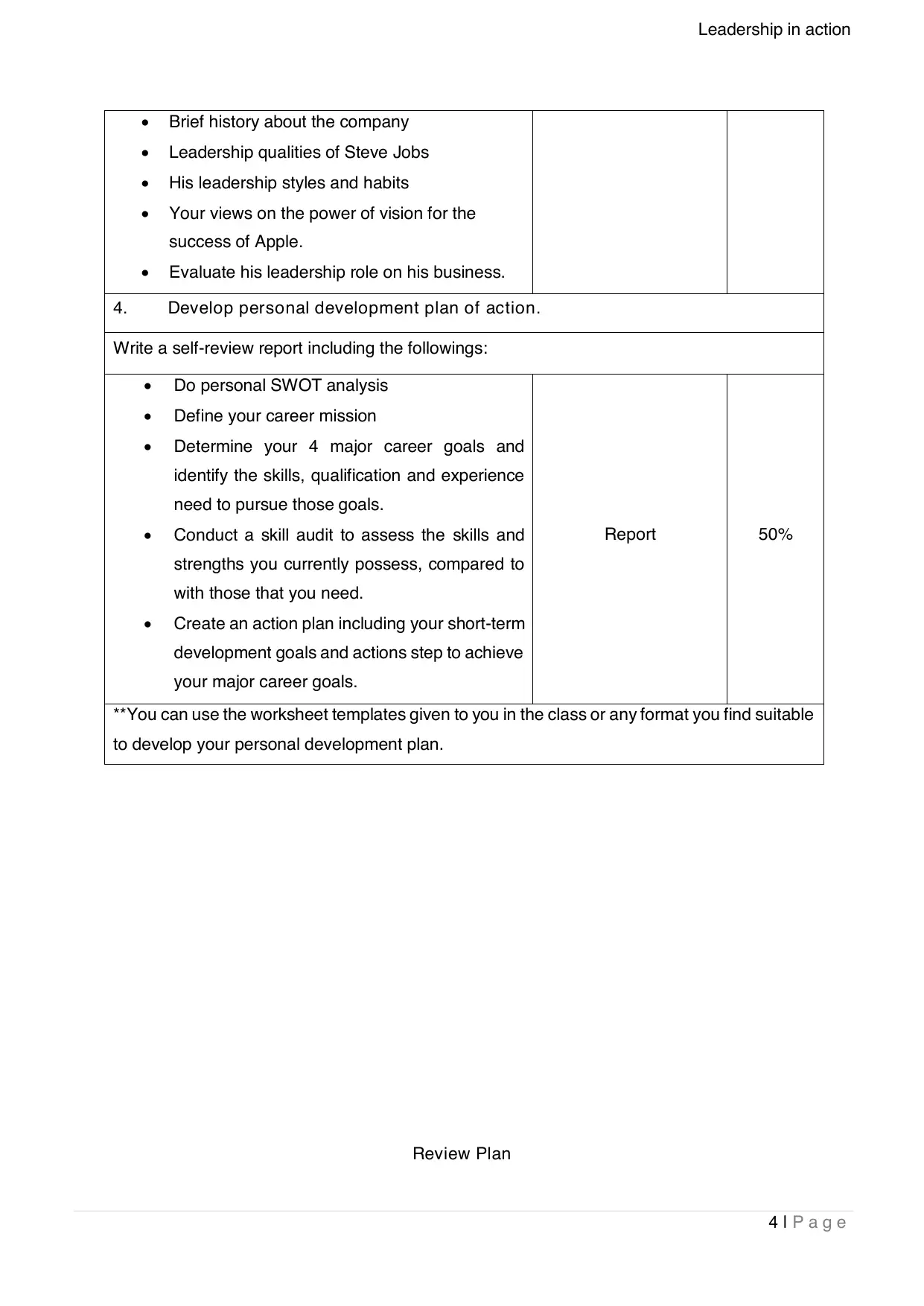
Leadership in action
4 | P a g e
Brief history about the company
Leadership qualities of Steve Jobs
His leadership styles and habits
Your views on the power of vision for the
success of Apple.
Evaluate his leadership role on his business.
4. Develop personal development plan of action.
Write a self-review report including the followings:
Do personal SWOT analysis
Define your career mission
Determine your 4 major career goals and
identify the skills, qualification and experience
need to pursue those goals.
Conduct a skill audit to assess the skills and
strengths you currently possess, compared to
with those that you need.
Create an action plan including your short-term
development goals and actions step to achieve
your major career goals.
Report 50%
**You can use the worksheet templates given to you in the class or any format you find suitable
to develop your personal development plan.
Review Plan
4 | P a g e
Brief history about the company
Leadership qualities of Steve Jobs
His leadership styles and habits
Your views on the power of vision for the
success of Apple.
Evaluate his leadership role on his business.
4. Develop personal development plan of action.
Write a self-review report including the followings:
Do personal SWOT analysis
Define your career mission
Determine your 4 major career goals and
identify the skills, qualification and experience
need to pursue those goals.
Conduct a skill audit to assess the skills and
strengths you currently possess, compared to
with those that you need.
Create an action plan including your short-term
development goals and actions step to achieve
your major career goals.
Report 50%
**You can use the worksheet templates given to you in the class or any format you find suitable
to develop your personal development plan.
Review Plan
Secure Best Marks with AI Grader
Need help grading? Try our AI Grader for instant feedback on your assignments.
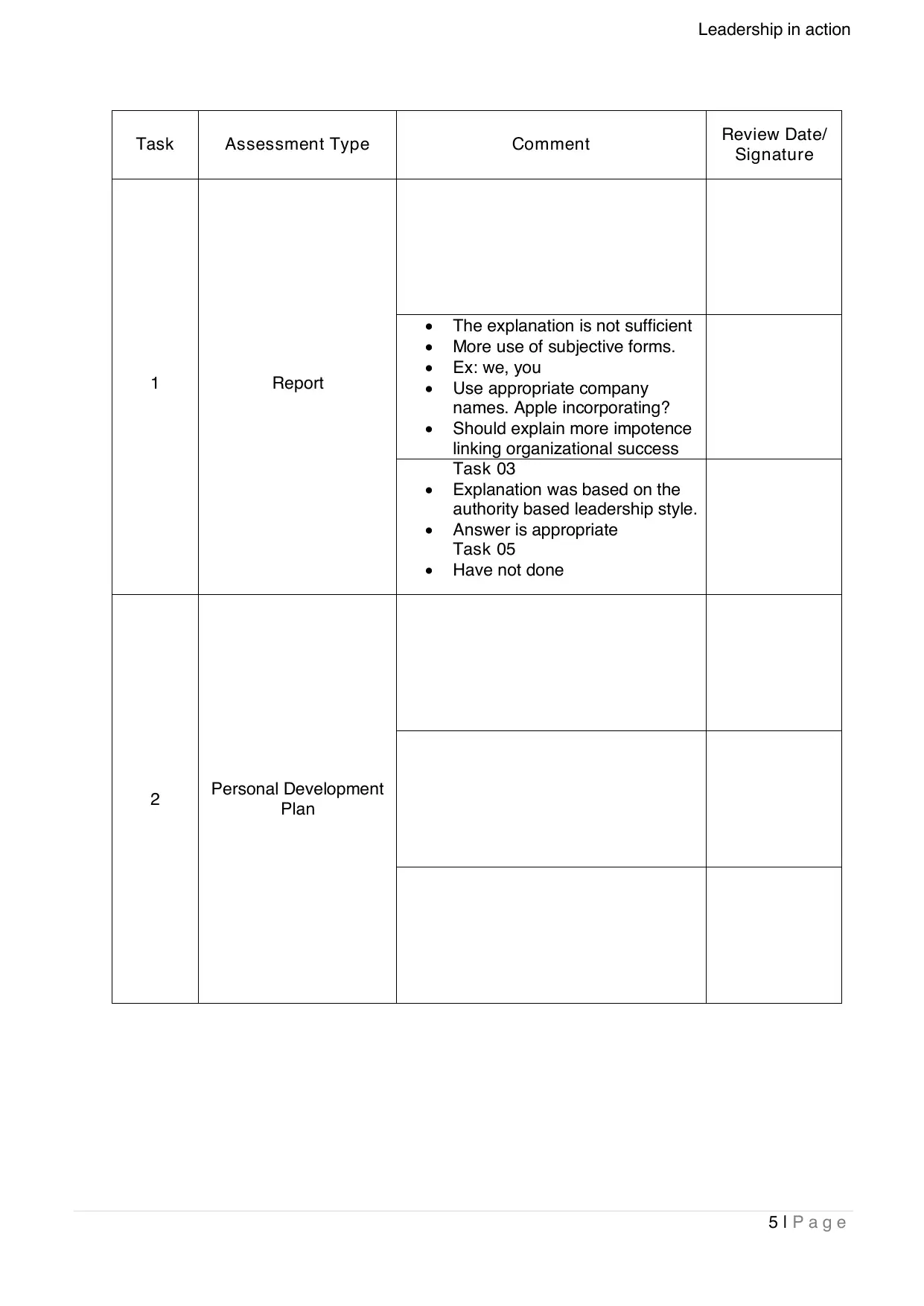
Leadership in action
5 | P a g e
Task Assessment Type Comment Review Date/
Signature
1 Report
The explanation is not sufficient
More use of subjective forms.
Ex: we, you
Use appropriate company
names. Apple incorporating?
Should explain more impotence
linking organizational success
Task 03
Explanation was based on the
authority based leadership style.
Answer is appropriate
Task 05
Have not done
2 Personal Development
Plan
5 | P a g e
Task Assessment Type Comment Review Date/
Signature
1 Report
The explanation is not sufficient
More use of subjective forms.
Ex: we, you
Use appropriate company
names. Apple incorporating?
Should explain more impotence
linking organizational success
Task 03
Explanation was based on the
authority based leadership style.
Answer is appropriate
Task 05
Have not done
2 Personal Development
Plan

Leadership in action
6 | P a g e
APPLE INC.
Name: Sureshkumar Prediksha
Batch: IFBM-15
Student No:1018426
6 | P a g e
APPLE INC.
Name: Sureshkumar Prediksha
Batch: IFBM-15
Student No:1018426

Leadership in action
7 | P a g e
ACKNOWLEDGMENT
I would like to express my deepest appreciation to all those who helped me to complete this report.
And my special thanks to Mrs. Jayani Hewavitharana, the lecture of “Leadership in action” of Bcas
Campus for making the subject more interesting and giving a great support to finish the report
successfully.
Further thanks to my colleagues who have been sharing knowledge and helping each other to clear
the doubts.
7 | P a g e
ACKNOWLEDGMENT
I would like to express my deepest appreciation to all those who helped me to complete this report.
And my special thanks to Mrs. Jayani Hewavitharana, the lecture of “Leadership in action” of Bcas
Campus for making the subject more interesting and giving a great support to finish the report
successfully.
Further thanks to my colleagues who have been sharing knowledge and helping each other to clear
the doubts.
Paraphrase This Document
Need a fresh take? Get an instant paraphrase of this document with our AI Paraphraser
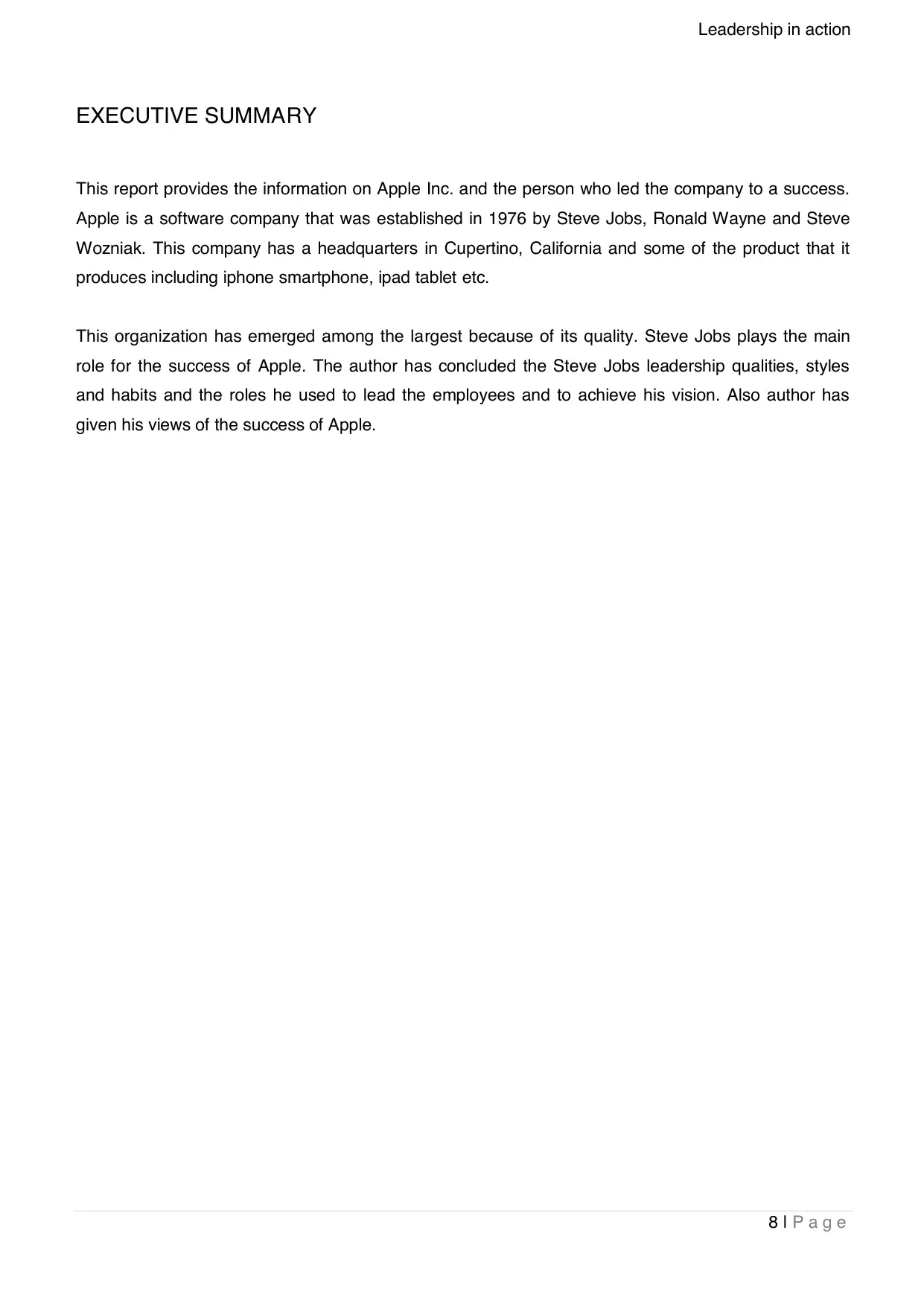
Leadership in action
8 | P a g e
EXECUTIVE SUMMARY
This report provides the information on Apple Inc. and the person who led the company to a success.
Apple is a software company that was established in 1976 by Steve Jobs, Ronald Wayne and Steve
Wozniak. This company has a headquarters in Cupertino, California and some of the product that it
produces including iphone smartphone, ipad tablet etc.
This organization has emerged among the largest because of its quality. Steve Jobs plays the main
role for the success of Apple. The author has concluded the Steve Jobs leadership qualities, styles
and habits and the roles he used to lead the employees and to achieve his vision. Also author has
given his views of the success of Apple.
8 | P a g e
EXECUTIVE SUMMARY
This report provides the information on Apple Inc. and the person who led the company to a success.
Apple is a software company that was established in 1976 by Steve Jobs, Ronald Wayne and Steve
Wozniak. This company has a headquarters in Cupertino, California and some of the product that it
produces including iphone smartphone, ipad tablet etc.
This organization has emerged among the largest because of its quality. Steve Jobs plays the main
role for the success of Apple. The author has concluded the Steve Jobs leadership qualities, styles
and habits and the roles he used to lead the employees and to achieve his vision. Also author has
given his views of the success of Apple.
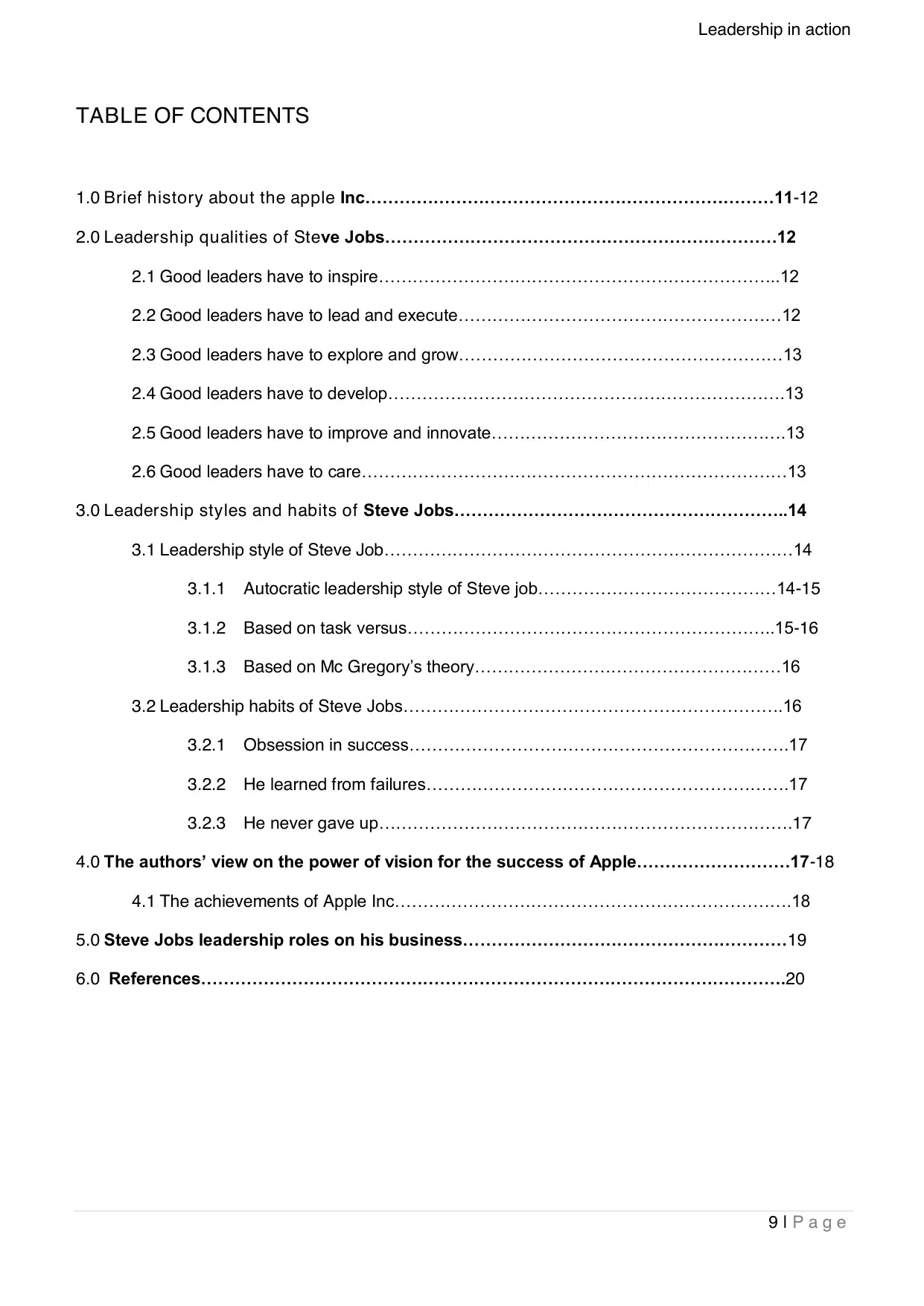
Leadership in action
9 | P a g e
TABLE OF CONTENTS
1.0 Brief history about the apple Inc………………………………………………………………11-12
2.0 Leadership qualities of Steve Jobs……………………………………………………………12
2.1 Good leaders have to inspire……………………………………………………………..12
2.2 Good leaders have to lead and execute…………………………………………………12
2.3 Good leaders have to explore and grow…………………………………………………13
2.4 Good leaders have to develop…………………………………………………………….13
2.5 Good leaders have to improve and innovate…………………………………………….13
2.6 Good leaders have to care…………………………………………………………………13
3.0 Leadership styles and habits of Steve Jobs…………………………………………………..14
3.1 Leadership style of Steve Job………………………………………………………………14
3.1.1 Autocratic leadership style of Steve job……………………………………14-15
3.1.2 Based on task versus………………………………………………………..15-16
3.1.3 Based on Mc Gregory’s theory………………………………………………16
3.2 Leadership habits of Steve Jobs………………………………………………………….16
3.2.1 Obsession in success………………………………………………………….17
3.2.2 He learned from failures……………………………………………………….17
3.2.3 He never gave up……………………………………………………………….17
4.0 The authors’ view on the power of vision for the success of Apple………………………17-18
4.1 The achievements of Apple Inc…………………………………………………………….18
5.0 Steve Jobs leadership roles on his business…………………………………………………19
6.0 References………………………………………………………………………………………….20
9 | P a g e
TABLE OF CONTENTS
1.0 Brief history about the apple Inc………………………………………………………………11-12
2.0 Leadership qualities of Steve Jobs……………………………………………………………12
2.1 Good leaders have to inspire……………………………………………………………..12
2.2 Good leaders have to lead and execute…………………………………………………12
2.3 Good leaders have to explore and grow…………………………………………………13
2.4 Good leaders have to develop…………………………………………………………….13
2.5 Good leaders have to improve and innovate…………………………………………….13
2.6 Good leaders have to care…………………………………………………………………13
3.0 Leadership styles and habits of Steve Jobs…………………………………………………..14
3.1 Leadership style of Steve Job………………………………………………………………14
3.1.1 Autocratic leadership style of Steve job……………………………………14-15
3.1.2 Based on task versus………………………………………………………..15-16
3.1.3 Based on Mc Gregory’s theory………………………………………………16
3.2 Leadership habits of Steve Jobs………………………………………………………….16
3.2.1 Obsession in success………………………………………………………….17
3.2.2 He learned from failures……………………………………………………….17
3.2.3 He never gave up……………………………………………………………….17
4.0 The authors’ view on the power of vision for the success of Apple………………………17-18
4.1 The achievements of Apple Inc…………………………………………………………….18
5.0 Steve Jobs leadership roles on his business…………………………………………………19
6.0 References………………………………………………………………………………………….20

Leadership in action
10 | P a g e
LIST OF FIGURES
Figure 3.1.2- task versus people……………………………………………………………………15
Figure 3.1.3- Mc gregor’s theory…………………………………………………………………….16
Figure 4.0- vision……………………………………………………………………………………...17
10 | P a g e
LIST OF FIGURES
Figure 3.1.2- task versus people……………………………………………………………………15
Figure 3.1.3- Mc gregor’s theory…………………………………………………………………….16
Figure 4.0- vision……………………………………………………………………………………...17
Secure Best Marks with AI Grader
Need help grading? Try our AI Grader for instant feedback on your assignments.

Leadership in action
11 | P a g e
1.0 BRIEF HISTORY ABOUT THE APPLE INC.
Apple Inc is an American Multinational Corporation that designs and manufactures consumer
electronics and computer software products (Paul suggett, 2019). The Apple Inc Co-founder,
Chairman and CEO is Steve Jobs. Apple Inc has achieved and officially become the first trillion
companies in history with its innovative products and services. But in the beginning there were many
struggles and failures. If we explore the history of the Apple Inc it was started only in a garage in
California to the present it is the most successful company in history (Fesmina Faizal, 2019).
In April 1, 1976, Apple was started by three college dropout men- Steve Jobs, Steve Wozniak and
Ronald Wayne. Jobs and Wozniak are highlighted as the most visible founders, but without their friend
Wayne. We would have not used the extraordinary products (Nik Rawlinson, 2017). Jobs and Wozniak
was the people involved in making computers small enough for people so they can use it in homes or
offices as a user-friendly product. Later, Jobs and Wozniak started to sell the Apple I in Jobs’ garage
without a monitor, keyboard, or casing in 1977. The Apple II computer with the first ever introduction of
colour graphics came to the industry and then the Apple II sales rapidly went high from $ 7.8 million in
1978 to $117 million in 1980. This is the year Apple went public.
In 1983, Wozniak left Apple due to lack of interest in the day to day running of Apple computers. Jobs
then hired PepsiCo’s John to be the president of the company. But because of some disagreement
Jobs left the company in 1985, and went on to new and bigger innovative products. He founded a new
company called NeXT SOFTWARE and also bought PIXAR from George Lucas. This later became a
huge success in computer animation movies such as Toy Story, Monsters, and Finding Nemo etc…
Later, in 1990 Apple was still doing good and posted its highest profits. This was mostly due to the
Jobs plans that he already set a vision before he leaves the company, most probably the deal between
small companies called Adobe, creator of the Adobe Portable Document Format. Together with the
company they named it Desktop Publishing. Also due to the request of Sculley in 1985, from Microsoft
founder Bill Gates to license the software. But later, this became a trouble to the Apple company
because Microsoft, whose windows operating systems graphical features are similar to the Apples’
software, became the toughest competition in the market in 1980’s to 1990’s.
In 1996, the Apple experts believed that the company would be doomed. So they were in need of an
Operating System so the board of directors decided to request Steve Jobs for help and they bought
NeXT Software from him. Also Steve Jobs helped the company to rise and became the Interim CEO
11 | P a g e
1.0 BRIEF HISTORY ABOUT THE APPLE INC.
Apple Inc is an American Multinational Corporation that designs and manufactures consumer
electronics and computer software products (Paul suggett, 2019). The Apple Inc Co-founder,
Chairman and CEO is Steve Jobs. Apple Inc has achieved and officially become the first trillion
companies in history with its innovative products and services. But in the beginning there were many
struggles and failures. If we explore the history of the Apple Inc it was started only in a garage in
California to the present it is the most successful company in history (Fesmina Faizal, 2019).
In April 1, 1976, Apple was started by three college dropout men- Steve Jobs, Steve Wozniak and
Ronald Wayne. Jobs and Wozniak are highlighted as the most visible founders, but without their friend
Wayne. We would have not used the extraordinary products (Nik Rawlinson, 2017). Jobs and Wozniak
was the people involved in making computers small enough for people so they can use it in homes or
offices as a user-friendly product. Later, Jobs and Wozniak started to sell the Apple I in Jobs’ garage
without a monitor, keyboard, or casing in 1977. The Apple II computer with the first ever introduction of
colour graphics came to the industry and then the Apple II sales rapidly went high from $ 7.8 million in
1978 to $117 million in 1980. This is the year Apple went public.
In 1983, Wozniak left Apple due to lack of interest in the day to day running of Apple computers. Jobs
then hired PepsiCo’s John to be the president of the company. But because of some disagreement
Jobs left the company in 1985, and went on to new and bigger innovative products. He founded a new
company called NeXT SOFTWARE and also bought PIXAR from George Lucas. This later became a
huge success in computer animation movies such as Toy Story, Monsters, and Finding Nemo etc…
Later, in 1990 Apple was still doing good and posted its highest profits. This was mostly due to the
Jobs plans that he already set a vision before he leaves the company, most probably the deal between
small companies called Adobe, creator of the Adobe Portable Document Format. Together with the
company they named it Desktop Publishing. Also due to the request of Sculley in 1985, from Microsoft
founder Bill Gates to license the software. But later, this became a trouble to the Apple company
because Microsoft, whose windows operating systems graphical features are similar to the Apples’
software, became the toughest competition in the market in 1980’s to 1990’s.
In 1996, the Apple experts believed that the company would be doomed. So they were in need of an
Operating System so the board of directors decided to request Steve Jobs for help and they bought
NeXT Software from him. Also Steve Jobs helped the company to rise and became the Interim CEO

Leadership in action
12 | P a g e
and made some changes in Apple. Jobs forged an alliance with Microsoft and created the Mac
version. Jobs also introduced the iBook (personal laptop), mp3 player (iPod) and media player
software (iTunes). Both players became the company's most profitable product. Later, he released
iPhones, a cellular phone and the Apple TV. while Jobs died in October 5, 2011. But still Apple is
running with his legacy with some developments (Angelique Richardson, 2008).
2.0 LEADERSHIP QUALITIES OF STEVE JOBS
Leader is the person who has the ability to change the behaviour of an individual or group of people to
get things done. Jobs led Apple Inc into one of the top companies in history. This was done because
of his concept of vision and his unique leadership style (accordingly, Achieve iconic team). He never
gives up on innovating new things. Even when he left Apple Inc in the beginning he started to produce
another new product to the market.
2.1 GOOD LEADERS HAVE TO INSPIRE
Steve Jobs is an inspirational leader; an individual can learn a number of lessons from him. Jobs
motivate, inspire and share the vision and sets clear goals for his team. His courage and confidence
gives inspiration to the employees and this drove them to act within a confidence on themselves. Jobs
always care about his future goals than thinking of his past failures. Jobs make a positive vibration in
the working place to make employees inspired.
“The power of questioning” (case study). According to Steve Jobs point of view questioning makes a
person more confident and encourages them to overcome the failures and to give a good result. Steve
Jobs was a risk taker after becoming the CEO of the company he shutdown the most sales revenue
company without thinking back because it didn’t fit his vision. After that he achieved the vision as he
dreamt. Through this it gives inspiration to the followers.
2.2 GOOD LEADERS HAVE TO LEAD AND EXECUTE
Steve Jobs leads and executes the employees towards its goals without significant deviations. This
accomplishes a great result of achievements of vision and objective of the Apple incorporation. He
executes more new versions of ideas to improve the company.
Jobs deliver motivational speech to his employees to get a better result. He led the company by
setting a vision and dealing with the challenges along the way. Jobs say his idea to his team and get a
better solution from his team. This way it creates a good relationship between the employees and also
better solutions. This makes the employee act loyal to his leader.
12 | P a g e
and made some changes in Apple. Jobs forged an alliance with Microsoft and created the Mac
version. Jobs also introduced the iBook (personal laptop), mp3 player (iPod) and media player
software (iTunes). Both players became the company's most profitable product. Later, he released
iPhones, a cellular phone and the Apple TV. while Jobs died in October 5, 2011. But still Apple is
running with his legacy with some developments (Angelique Richardson, 2008).
2.0 LEADERSHIP QUALITIES OF STEVE JOBS
Leader is the person who has the ability to change the behaviour of an individual or group of people to
get things done. Jobs led Apple Inc into one of the top companies in history. This was done because
of his concept of vision and his unique leadership style (accordingly, Achieve iconic team). He never
gives up on innovating new things. Even when he left Apple Inc in the beginning he started to produce
another new product to the market.
2.1 GOOD LEADERS HAVE TO INSPIRE
Steve Jobs is an inspirational leader; an individual can learn a number of lessons from him. Jobs
motivate, inspire and share the vision and sets clear goals for his team. His courage and confidence
gives inspiration to the employees and this drove them to act within a confidence on themselves. Jobs
always care about his future goals than thinking of his past failures. Jobs make a positive vibration in
the working place to make employees inspired.
“The power of questioning” (case study). According to Steve Jobs point of view questioning makes a
person more confident and encourages them to overcome the failures and to give a good result. Steve
Jobs was a risk taker after becoming the CEO of the company he shutdown the most sales revenue
company without thinking back because it didn’t fit his vision. After that he achieved the vision as he
dreamt. Through this it gives inspiration to the followers.
2.2 GOOD LEADERS HAVE TO LEAD AND EXECUTE
Steve Jobs leads and executes the employees towards its goals without significant deviations. This
accomplishes a great result of achievements of vision and objective of the Apple incorporation. He
executes more new versions of ideas to improve the company.
Jobs deliver motivational speech to his employees to get a better result. He led the company by
setting a vision and dealing with the challenges along the way. Jobs say his idea to his team and get a
better solution from his team. This way it creates a good relationship between the employees and also
better solutions. This makes the employee act loyal to his leader.
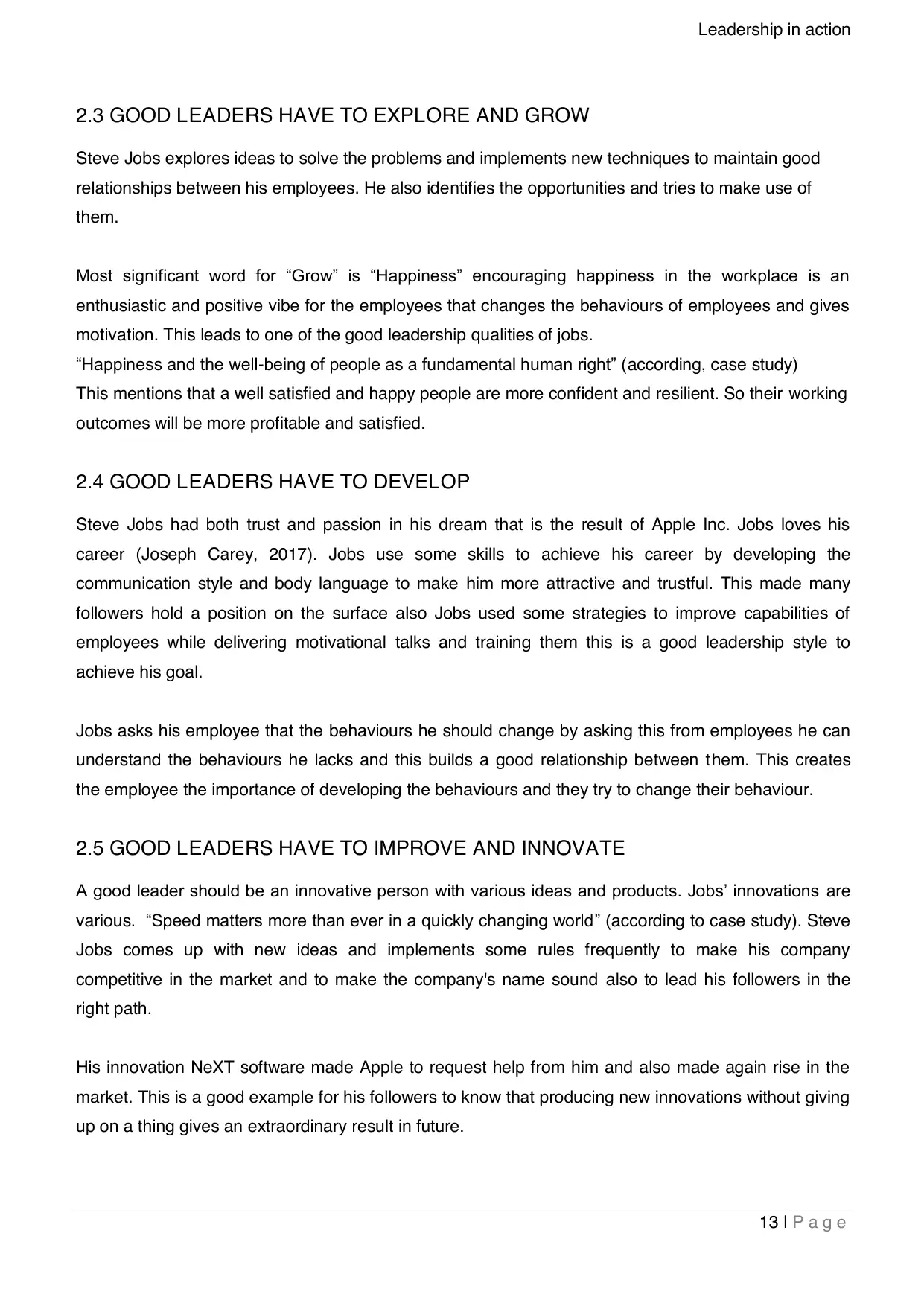
Leadership in action
13 | P a g e
2.3 GOOD LEADERS HAVE TO EXPLORE AND GROW
Steve Jobs explores ideas to solve the problems and implements new techniques to maintain good
relationships between his employees. He also identifies the opportunities and tries to make use of
them.
Most significant word for “Grow” is “Happiness” encouraging happiness in the workplace is an
enthusiastic and positive vibe for the employees that changes the behaviours of employees and gives
motivation. This leads to one of the good leadership qualities of jobs.
“Happiness and the well-being of people as a fundamental human right” (according, case study)
This mentions that a well satisfied and happy people are more confident and resilient. So their working
outcomes will be more profitable and satisfied.
2.4 GOOD LEADERS HAVE TO DEVELOP
Steve Jobs had both trust and passion in his dream that is the result of Apple Inc. Jobs loves his
career (Joseph Carey, 2017). Jobs use some skills to achieve his career by developing the
communication style and body language to make him more attractive and trustful. This made many
followers hold a position on the surface also Jobs used some strategies to improve capabilities of
employees while delivering motivational talks and training them this is a good leadership style to
achieve his goal.
Jobs asks his employee that the behaviours he should change by asking this from employees he can
understand the behaviours he lacks and this builds a good relationship between them. This creates
the employee the importance of developing the behaviours and they try to change their behaviour.
2.5 GOOD LEADERS HAVE TO IMPROVE AND INNOVATE
A good leader should be an innovative person with various ideas and products. Jobs’ innovations are
various. “Speed matters more than ever in a quickly changing world” (according to case study). Steve
Jobs comes up with new ideas and implements some rules frequently to make his company
competitive in the market and to make the company's name sound also to lead his followers in the
right path.
His innovation NeXT software made Apple to request help from him and also made again rise in the
market. This is a good example for his followers to know that producing new innovations without giving
up on a thing gives an extraordinary result in future.
13 | P a g e
2.3 GOOD LEADERS HAVE TO EXPLORE AND GROW
Steve Jobs explores ideas to solve the problems and implements new techniques to maintain good
relationships between his employees. He also identifies the opportunities and tries to make use of
them.
Most significant word for “Grow” is “Happiness” encouraging happiness in the workplace is an
enthusiastic and positive vibe for the employees that changes the behaviours of employees and gives
motivation. This leads to one of the good leadership qualities of jobs.
“Happiness and the well-being of people as a fundamental human right” (according, case study)
This mentions that a well satisfied and happy people are more confident and resilient. So their working
outcomes will be more profitable and satisfied.
2.4 GOOD LEADERS HAVE TO DEVELOP
Steve Jobs had both trust and passion in his dream that is the result of Apple Inc. Jobs loves his
career (Joseph Carey, 2017). Jobs use some skills to achieve his career by developing the
communication style and body language to make him more attractive and trustful. This made many
followers hold a position on the surface also Jobs used some strategies to improve capabilities of
employees while delivering motivational talks and training them this is a good leadership style to
achieve his goal.
Jobs asks his employee that the behaviours he should change by asking this from employees he can
understand the behaviours he lacks and this builds a good relationship between them. This creates
the employee the importance of developing the behaviours and they try to change their behaviour.
2.5 GOOD LEADERS HAVE TO IMPROVE AND INNOVATE
A good leader should be an innovative person with various ideas and products. Jobs’ innovations are
various. “Speed matters more than ever in a quickly changing world” (according to case study). Steve
Jobs comes up with new ideas and implements some rules frequently to make his company
competitive in the market and to make the company's name sound also to lead his followers in the
right path.
His innovation NeXT software made Apple to request help from him and also made again rise in the
market. This is a good example for his followers to know that producing new innovations without giving
up on a thing gives an extraordinary result in future.
Paraphrase This Document
Need a fresh take? Get an instant paraphrase of this document with our AI Paraphraser
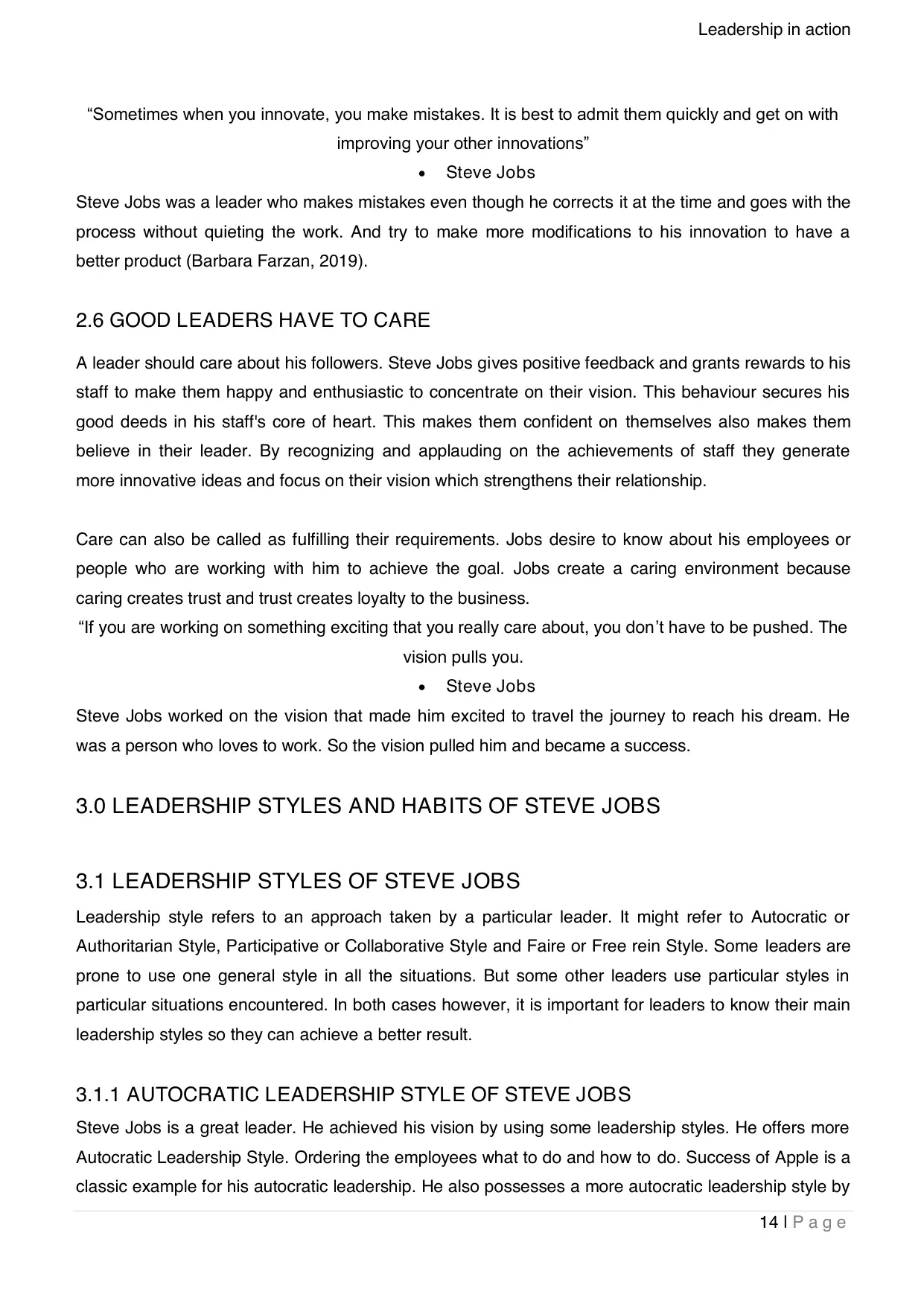
Leadership in action
14 | P a g e
“Sometimes when you innovate, you make mistakes. It is best to admit them quickly and get on with
improving your other innovations”
Steve Jobs
Steve Jobs was a leader who makes mistakes even though he corrects it at the time and goes with the
process without quieting the work. And try to make more modifications to his innovation to have a
better product (Barbara Farzan, 2019).
2.6 GOOD LEADERS HAVE TO CARE
A leader should care about his followers. Steve Jobs gives positive feedback and grants rewards to his
staff to make them happy and enthusiastic to concentrate on their vision. This behaviour secures his
good deeds in his staff's core of heart. This makes them confident on themselves also makes them
believe in their leader. By recognizing and applauding on the achievements of staff they generate
more innovative ideas and focus on their vision which strengthens their relationship.
Care can also be called as fulfilling their requirements. Jobs desire to know about his employees or
people who are working with him to achieve the goal. Jobs create a caring environment because
caring creates trust and trust creates loyalty to the business.
“If you are working on something exciting that you really care about, you don’t have to be pushed. The
vision pulls you.
Steve Jobs
Steve Jobs worked on the vision that made him excited to travel the journey to reach his dream. He
was a person who loves to work. So the vision pulled him and became a success.
3.0 LEADERSHIP STYLES AND HABITS OF STEVE JOBS
3.1 LEADERSHIP STYLES OF STEVE JOBS
Leadership style refers to an approach taken by a particular leader. It might refer to Autocratic or
Authoritarian Style, Participative or Collaborative Style and Faire or Free rein Style. Some leaders are
prone to use one general style in all the situations. But some other leaders use particular styles in
particular situations encountered. In both cases however, it is important for leaders to know their main
leadership styles so they can achieve a better result.
3.1.1 AUTOCRATIC LEADERSHIP STYLE OF STEVE JOBS
Steve Jobs is a great leader. He achieved his vision by using some leadership styles. He offers more
Autocratic Leadership Style. Ordering the employees what to do and how to do. Success of Apple is a
classic example for his autocratic leadership. He also possesses a more autocratic leadership style by
14 | P a g e
“Sometimes when you innovate, you make mistakes. It is best to admit them quickly and get on with
improving your other innovations”
Steve Jobs
Steve Jobs was a leader who makes mistakes even though he corrects it at the time and goes with the
process without quieting the work. And try to make more modifications to his innovation to have a
better product (Barbara Farzan, 2019).
2.6 GOOD LEADERS HAVE TO CARE
A leader should care about his followers. Steve Jobs gives positive feedback and grants rewards to his
staff to make them happy and enthusiastic to concentrate on their vision. This behaviour secures his
good deeds in his staff's core of heart. This makes them confident on themselves also makes them
believe in their leader. By recognizing and applauding on the achievements of staff they generate
more innovative ideas and focus on their vision which strengthens their relationship.
Care can also be called as fulfilling their requirements. Jobs desire to know about his employees or
people who are working with him to achieve the goal. Jobs create a caring environment because
caring creates trust and trust creates loyalty to the business.
“If you are working on something exciting that you really care about, you don’t have to be pushed. The
vision pulls you.
Steve Jobs
Steve Jobs worked on the vision that made him excited to travel the journey to reach his dream. He
was a person who loves to work. So the vision pulled him and became a success.
3.0 LEADERSHIP STYLES AND HABITS OF STEVE JOBS
3.1 LEADERSHIP STYLES OF STEVE JOBS
Leadership style refers to an approach taken by a particular leader. It might refer to Autocratic or
Authoritarian Style, Participative or Collaborative Style and Faire or Free rein Style. Some leaders are
prone to use one general style in all the situations. But some other leaders use particular styles in
particular situations encountered. In both cases however, it is important for leaders to know their main
leadership styles so they can achieve a better result.
3.1.1 AUTOCRATIC LEADERSHIP STYLE OF STEVE JOBS
Steve Jobs is a great leader. He achieved his vision by using some leadership styles. He offers more
Autocratic Leadership Style. Ordering the employees what to do and how to do. Success of Apple is a
classic example for his autocratic leadership. He also possesses a more autocratic leadership style by
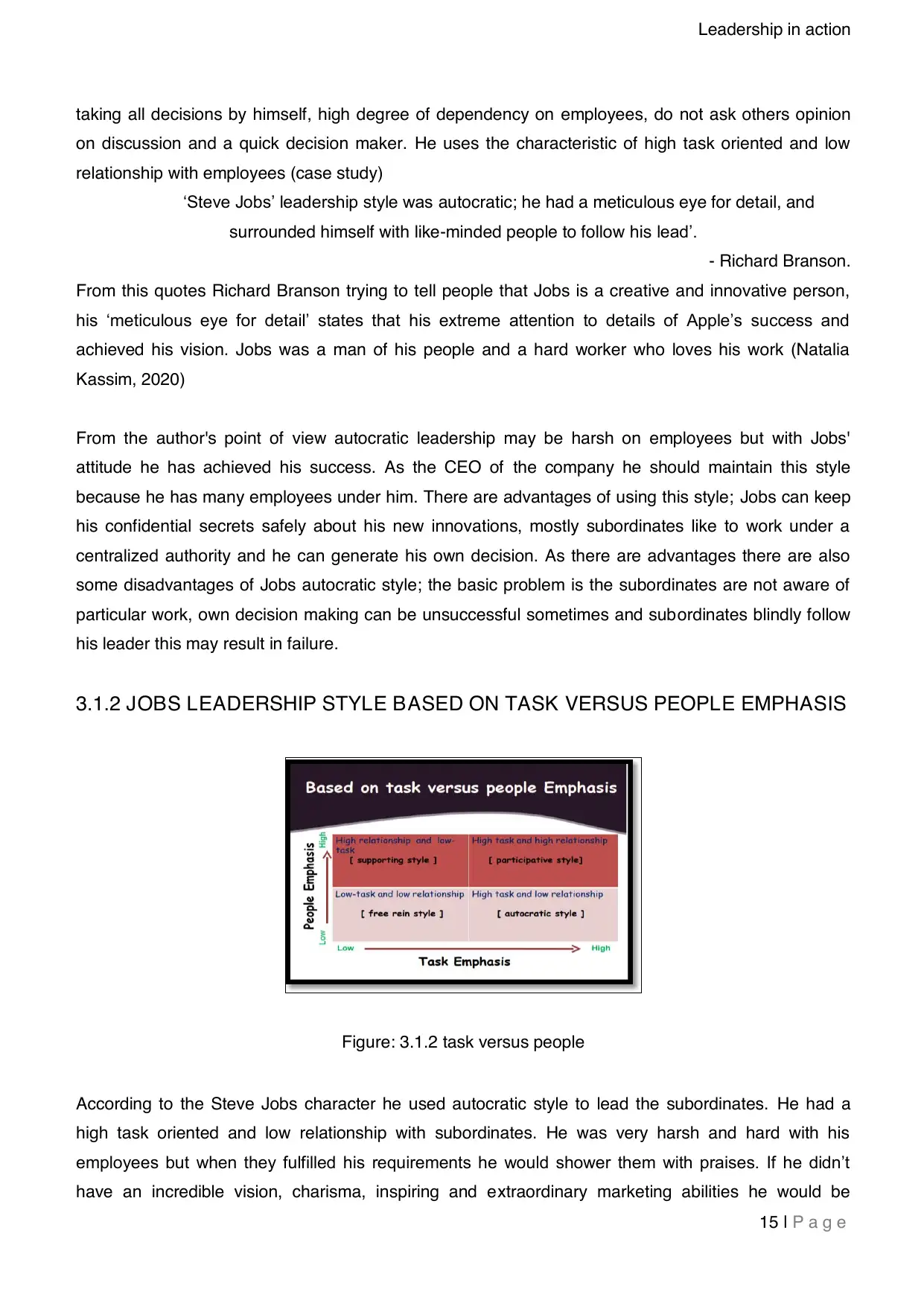
Leadership in action
15 | P a g e
taking all decisions by himself, high degree of dependency on employees, do not ask others opinion
on discussion and a quick decision maker. He uses the characteristic of high task oriented and low
relationship with employees (case study)
‘Steve Jobs’ leadership style was autocratic; he had a meticulous eye for detail, and
surrounded himself with like-minded people to follow his lead’.
- Richard Branson.
From this quotes Richard Branson trying to tell people that Jobs is a creative and innovative person,
his ‘meticulous eye for detail’ states that his extreme attention to details of Apple’s success and
achieved his vision. Jobs was a man of his people and a hard worker who loves his work (Natalia
Kassim, 2020)
From the author's point of view autocratic leadership may be harsh on employees but with Jobs'
attitude he has achieved his success. As the CEO of the company he should maintain this style
because he has many employees under him. There are advantages of using this style; Jobs can keep
his confidential secrets safely about his new innovations, mostly subordinates like to work under a
centralized authority and he can generate his own decision. As there are advantages there are also
some disadvantages of Jobs autocratic style; the basic problem is the subordinates are not aware of
particular work, own decision making can be unsuccessful sometimes and subordinates blindly follow
his leader this may result in failure.
3.1.2 JOBS LEADERSHIP STYLE BASED ON TASK VERSUS PEOPLE EMPHASIS
Figure: 3.1.2 task versus people
According to the Steve Jobs character he used autocratic style to lead the subordinates. He had a
high task oriented and low relationship with subordinates. He was very harsh and hard with his
employees but when they fulfilled his requirements he would shower them with praises. If he didn’t
have an incredible vision, charisma, inspiring and extraordinary marketing abilities he would be
15 | P a g e
taking all decisions by himself, high degree of dependency on employees, do not ask others opinion
on discussion and a quick decision maker. He uses the characteristic of high task oriented and low
relationship with employees (case study)
‘Steve Jobs’ leadership style was autocratic; he had a meticulous eye for detail, and
surrounded himself with like-minded people to follow his lead’.
- Richard Branson.
From this quotes Richard Branson trying to tell people that Jobs is a creative and innovative person,
his ‘meticulous eye for detail’ states that his extreme attention to details of Apple’s success and
achieved his vision. Jobs was a man of his people and a hard worker who loves his work (Natalia
Kassim, 2020)
From the author's point of view autocratic leadership may be harsh on employees but with Jobs'
attitude he has achieved his success. As the CEO of the company he should maintain this style
because he has many employees under him. There are advantages of using this style; Jobs can keep
his confidential secrets safely about his new innovations, mostly subordinates like to work under a
centralized authority and he can generate his own decision. As there are advantages there are also
some disadvantages of Jobs autocratic style; the basic problem is the subordinates are not aware of
particular work, own decision making can be unsuccessful sometimes and subordinates blindly follow
his leader this may result in failure.
3.1.2 JOBS LEADERSHIP STYLE BASED ON TASK VERSUS PEOPLE EMPHASIS
Figure: 3.1.2 task versus people
According to the Steve Jobs character he used autocratic style to lead the subordinates. He had a
high task oriented and low relationship with subordinates. He was very harsh and hard with his
employees but when they fulfilled his requirements he would shower them with praises. If he didn’t
have an incredible vision, charisma, inspiring and extraordinary marketing abilities he would be
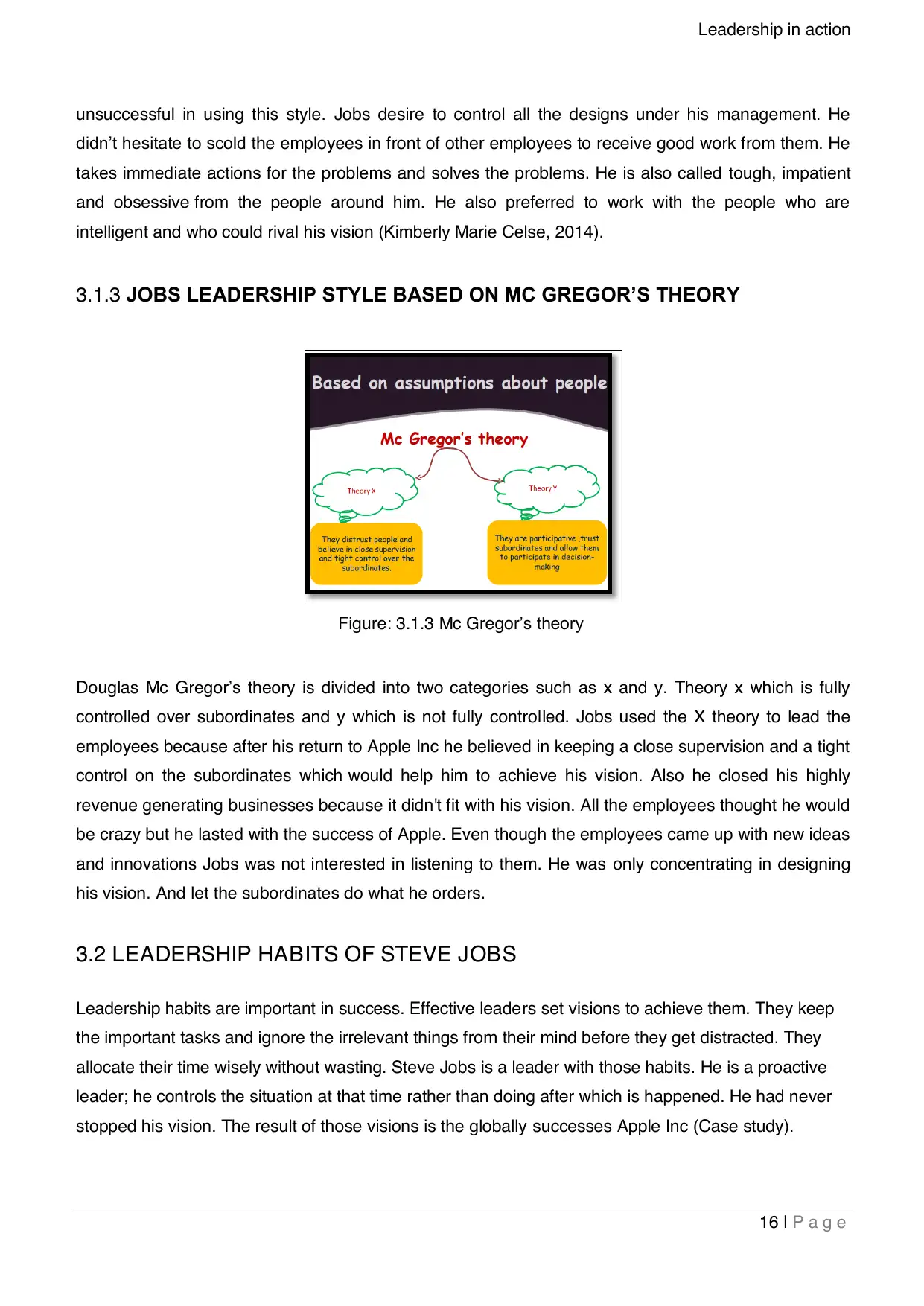
Leadership in action
16 | P a g e
unsuccessful in using this style. Jobs desire to control all the designs under his management. He
didn’t hesitate to scold the employees in front of other employees to receive good work from them. He
takes immediate actions for the problems and solves the problems. He is also called tough, impatient
and obsessive from the people around him. He also preferred to work with the people who are
intelligent and who could rival his vision (Kimberly Marie Celse, 2014).
3.1.3 JOBS LEADERSHIP STYLE BASED ON MC GREGOR’S THEORY
Figure: 3.1.3 Mc Gregor’s theory
Douglas Mc Gregor’s theory is divided into two categories such as x and y. Theory x which is fully
controlled over subordinates and y which is not fully controlled. Jobs used the X theory to lead the
employees because after his return to Apple Inc he believed in keeping a close supervision and a tight
control on the subordinates which would help him to achieve his vision. Also he closed his highly
revenue generating businesses because it didn't fit with his vision. All the employees thought he would
be crazy but he lasted with the success of Apple. Even though the employees came up with new ideas
and innovations Jobs was not interested in listening to them. He was only concentrating in designing
his vision. And let the subordinates do what he orders.
3.2 LEADERSHIP HABITS OF STEVE JOBS
Leadership habits are important in success. Effective leaders set visions to achieve them. They keep
the important tasks and ignore the irrelevant things from their mind before they get distracted. They
allocate their time wisely without wasting. Steve Jobs is a leader with those habits. He is a proactive
leader; he controls the situation at that time rather than doing after which is happened. He had never
stopped his vision. The result of those visions is the globally successes Apple Inc (Case study).
16 | P a g e
unsuccessful in using this style. Jobs desire to control all the designs under his management. He
didn’t hesitate to scold the employees in front of other employees to receive good work from them. He
takes immediate actions for the problems and solves the problems. He is also called tough, impatient
and obsessive from the people around him. He also preferred to work with the people who are
intelligent and who could rival his vision (Kimberly Marie Celse, 2014).
3.1.3 JOBS LEADERSHIP STYLE BASED ON MC GREGOR’S THEORY
Figure: 3.1.3 Mc Gregor’s theory
Douglas Mc Gregor’s theory is divided into two categories such as x and y. Theory x which is fully
controlled over subordinates and y which is not fully controlled. Jobs used the X theory to lead the
employees because after his return to Apple Inc he believed in keeping a close supervision and a tight
control on the subordinates which would help him to achieve his vision. Also he closed his highly
revenue generating businesses because it didn't fit with his vision. All the employees thought he would
be crazy but he lasted with the success of Apple. Even though the employees came up with new ideas
and innovations Jobs was not interested in listening to them. He was only concentrating in designing
his vision. And let the subordinates do what he orders.
3.2 LEADERSHIP HABITS OF STEVE JOBS
Leadership habits are important in success. Effective leaders set visions to achieve them. They keep
the important tasks and ignore the irrelevant things from their mind before they get distracted. They
allocate their time wisely without wasting. Steve Jobs is a leader with those habits. He is a proactive
leader; he controls the situation at that time rather than doing after which is happened. He had never
stopped his vision. The result of those visions is the globally successes Apple Inc (Case study).
Secure Best Marks with AI Grader
Need help grading? Try our AI Grader for instant feedback on your assignments.
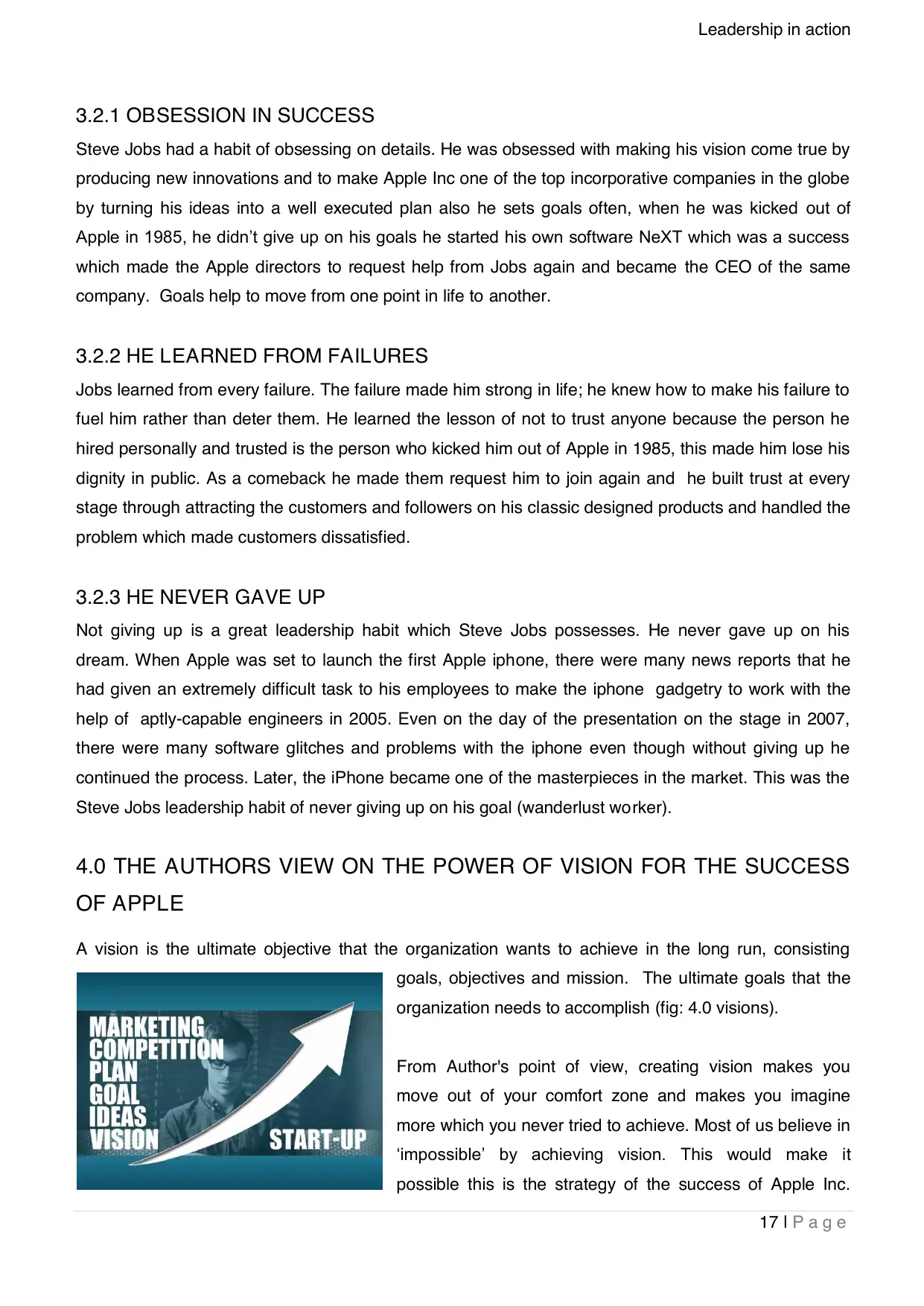
Leadership in action
17 | P a g e
3.2.1 OBSESSION IN SUCCESS
Steve Jobs had a habit of obsessing on details. He was obsessed with making his vision come true by
producing new innovations and to make Apple Inc one of the top incorporative companies in the globe
by turning his ideas into a well executed plan also he sets goals often, when he was kicked out of
Apple in 1985, he didn’t give up on his goals he started his own software NeXT which was a success
which made the Apple directors to request help from Jobs again and became the CEO of the same
company. Goals help to move from one point in life to another.
3.2.2 HE LEARNED FROM FAILURES
Jobs learned from every failure. The failure made him strong in life; he knew how to make his failure to
fuel him rather than deter them. He learned the lesson of not to trust anyone because the person he
hired personally and trusted is the person who kicked him out of Apple in 1985, this made him lose his
dignity in public. As a comeback he made them request him to join again and he built trust at every
stage through attracting the customers and followers on his classic designed products and handled the
problem which made customers dissatisfied.
3.2.3 HE NEVER GAVE UP
Not giving up is a great leadership habit which Steve Jobs possesses. He never gave up on his
dream. When Apple was set to launch the first Apple iphone, there were many news reports that he
had given an extremely difficult task to his employees to make the iphone gadgetry to work with the
help of aptly-capable engineers in 2005. Even on the day of the presentation on the stage in 2007,
there were many software glitches and problems with the iphone even though without giving up he
continued the process. Later, the iPhone became one of the masterpieces in the market. This was the
Steve Jobs leadership habit of never giving up on his goal (wanderlust worker).
4.0 THE AUTHORS VIEW ON THE POWER OF VISION FOR THE SUCCESS
OF APPLE
A vision is the ultimate objective that the organization wants to achieve in the long run, consisting
goals, objectives and mission. The ultimate goals that the
organization needs to accomplish (fig: 4.0 visions).
From Author's point of view, creating vision makes you
move out of your comfort zone and makes you imagine
more which you never tried to achieve. Most of us believe in
‘impossible’ by achieving vision. This would make it
possible this is the strategy of the success of Apple Inc.
17 | P a g e
3.2.1 OBSESSION IN SUCCESS
Steve Jobs had a habit of obsessing on details. He was obsessed with making his vision come true by
producing new innovations and to make Apple Inc one of the top incorporative companies in the globe
by turning his ideas into a well executed plan also he sets goals often, when he was kicked out of
Apple in 1985, he didn’t give up on his goals he started his own software NeXT which was a success
which made the Apple directors to request help from Jobs again and became the CEO of the same
company. Goals help to move from one point in life to another.
3.2.2 HE LEARNED FROM FAILURES
Jobs learned from every failure. The failure made him strong in life; he knew how to make his failure to
fuel him rather than deter them. He learned the lesson of not to trust anyone because the person he
hired personally and trusted is the person who kicked him out of Apple in 1985, this made him lose his
dignity in public. As a comeback he made them request him to join again and he built trust at every
stage through attracting the customers and followers on his classic designed products and handled the
problem which made customers dissatisfied.
3.2.3 HE NEVER GAVE UP
Not giving up is a great leadership habit which Steve Jobs possesses. He never gave up on his
dream. When Apple was set to launch the first Apple iphone, there were many news reports that he
had given an extremely difficult task to his employees to make the iphone gadgetry to work with the
help of aptly-capable engineers in 2005. Even on the day of the presentation on the stage in 2007,
there were many software glitches and problems with the iphone even though without giving up he
continued the process. Later, the iPhone became one of the masterpieces in the market. This was the
Steve Jobs leadership habit of never giving up on his goal (wanderlust worker).
4.0 THE AUTHORS VIEW ON THE POWER OF VISION FOR THE SUCCESS
OF APPLE
A vision is the ultimate objective that the organization wants to achieve in the long run, consisting
goals, objectives and mission. The ultimate goals that the
organization needs to accomplish (fig: 4.0 visions).
From Author's point of view, creating vision makes you
move out of your comfort zone and makes you imagine
more which you never tried to achieve. Most of us believe in
‘impossible’ by achieving vision. This would make it
possible this is the strategy of the success of Apple Inc.
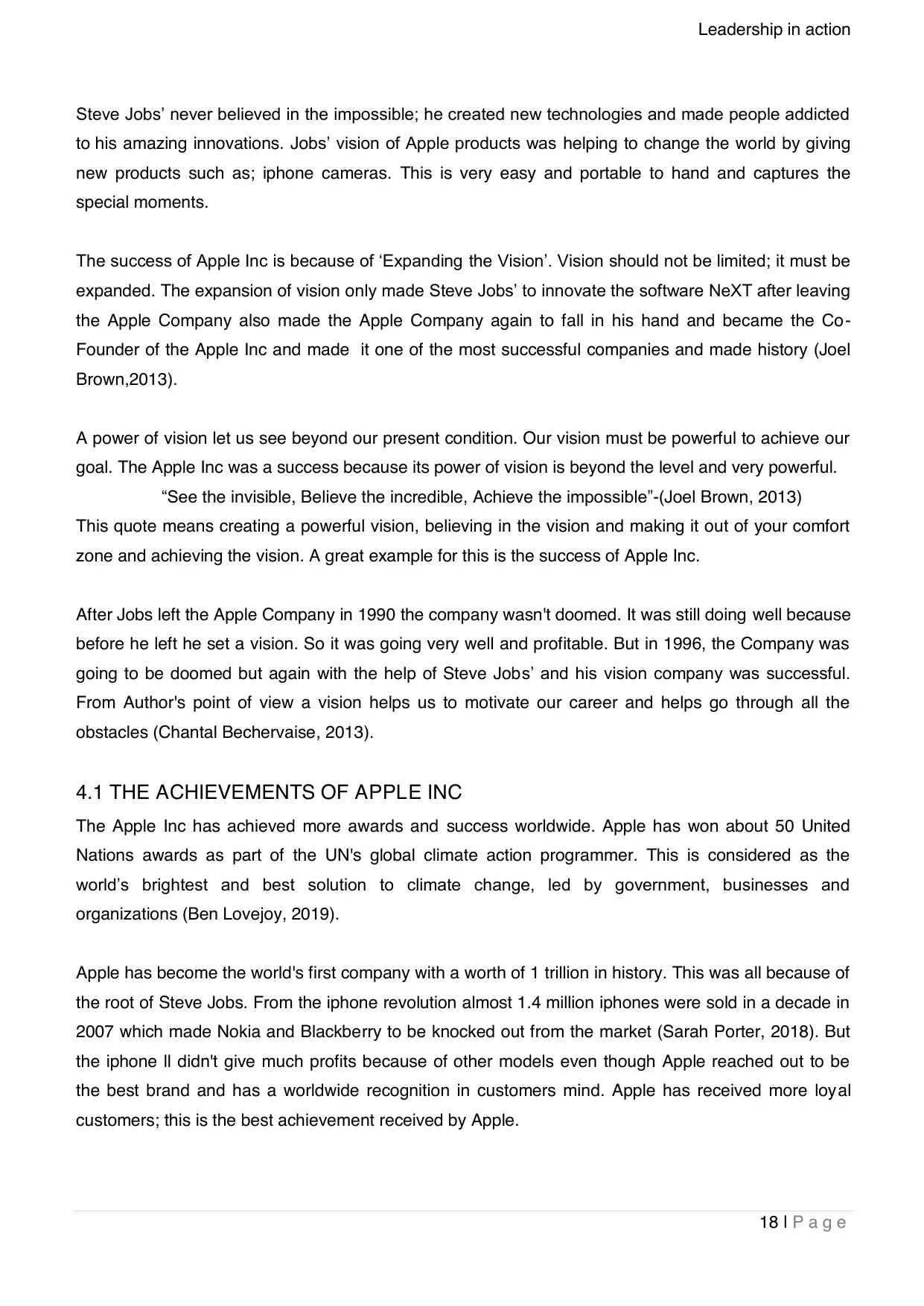
Leadership in action
18 | P a g e
Steve Jobs’ never believed in the impossible; he created new technologies and made people addicted
to his amazing innovations. Jobs’ vision of Apple products was helping to change the world by giving
new products such as; iphone cameras. This is very easy and portable to hand and captures the
special moments.
The success of Apple Inc is because of ‘Expanding the Vision’. Vision should not be limited; it must be
expanded. The expansion of vision only made Steve Jobs’ to innovate the software NeXT after leaving
the Apple Company also made the Apple Company again to fall in his hand and became the Co-
Founder of the Apple Inc and made it one of the most successful companies and made history (Joel
Brown,2013).
A power of vision let us see beyond our present condition. Our vision must be powerful to achieve our
goal. The Apple Inc was a success because its power of vision is beyond the level and very powerful.
“See the invisible, Believe the incredible, Achieve the impossible”-(Joel Brown, 2013)
This quote means creating a powerful vision, believing in the vision and making it out of your comfort
zone and achieving the vision. A great example for this is the success of Apple Inc.
After Jobs left the Apple Company in 1990 the company wasn't doomed. It was still doing well because
before he left he set a vision. So it was going very well and profitable. But in 1996, the Company was
going to be doomed but again with the help of Steve Jobs’ and his vision company was successful.
From Author's point of view a vision helps us to motivate our career and helps go through all the
obstacles (Chantal Bechervaise, 2013).
4.1 THE ACHIEVEMENTS OF APPLE INC
The Apple Inc has achieved more awards and success worldwide. Apple has won about 50 United
Nations awards as part of the UN's global climate action programmer. This is considered as the
world’s brightest and best solution to climate change, led by government, businesses and
organizations (Ben Lovejoy, 2019).
Apple has become the world's first company with a worth of 1 trillion in history. This was all because of
the root of Steve Jobs. From the iphone revolution almost 1.4 million iphones were sold in a decade in
2007 which made Nokia and Blackberry to be knocked out from the market (Sarah Porter, 2018). But
the iphone ll didn't give much profits because of other models even though Apple reached out to be
the best brand and has a worldwide recognition in customers mind. Apple has received more loyal
customers; this is the best achievement received by Apple.
18 | P a g e
Steve Jobs’ never believed in the impossible; he created new technologies and made people addicted
to his amazing innovations. Jobs’ vision of Apple products was helping to change the world by giving
new products such as; iphone cameras. This is very easy and portable to hand and captures the
special moments.
The success of Apple Inc is because of ‘Expanding the Vision’. Vision should not be limited; it must be
expanded. The expansion of vision only made Steve Jobs’ to innovate the software NeXT after leaving
the Apple Company also made the Apple Company again to fall in his hand and became the Co-
Founder of the Apple Inc and made it one of the most successful companies and made history (Joel
Brown,2013).
A power of vision let us see beyond our present condition. Our vision must be powerful to achieve our
goal. The Apple Inc was a success because its power of vision is beyond the level and very powerful.
“See the invisible, Believe the incredible, Achieve the impossible”-(Joel Brown, 2013)
This quote means creating a powerful vision, believing in the vision and making it out of your comfort
zone and achieving the vision. A great example for this is the success of Apple Inc.
After Jobs left the Apple Company in 1990 the company wasn't doomed. It was still doing well because
before he left he set a vision. So it was going very well and profitable. But in 1996, the Company was
going to be doomed but again with the help of Steve Jobs’ and his vision company was successful.
From Author's point of view a vision helps us to motivate our career and helps go through all the
obstacles (Chantal Bechervaise, 2013).
4.1 THE ACHIEVEMENTS OF APPLE INC
The Apple Inc has achieved more awards and success worldwide. Apple has won about 50 United
Nations awards as part of the UN's global climate action programmer. This is considered as the
world’s brightest and best solution to climate change, led by government, businesses and
organizations (Ben Lovejoy, 2019).
Apple has become the world's first company with a worth of 1 trillion in history. This was all because of
the root of Steve Jobs. From the iphone revolution almost 1.4 million iphones were sold in a decade in
2007 which made Nokia and Blackberry to be knocked out from the market (Sarah Porter, 2018). But
the iphone ll didn't give much profits because of other models even though Apple reached out to be
the best brand and has a worldwide recognition in customers mind. Apple has received more loyal
customers; this is the best achievement received by Apple.
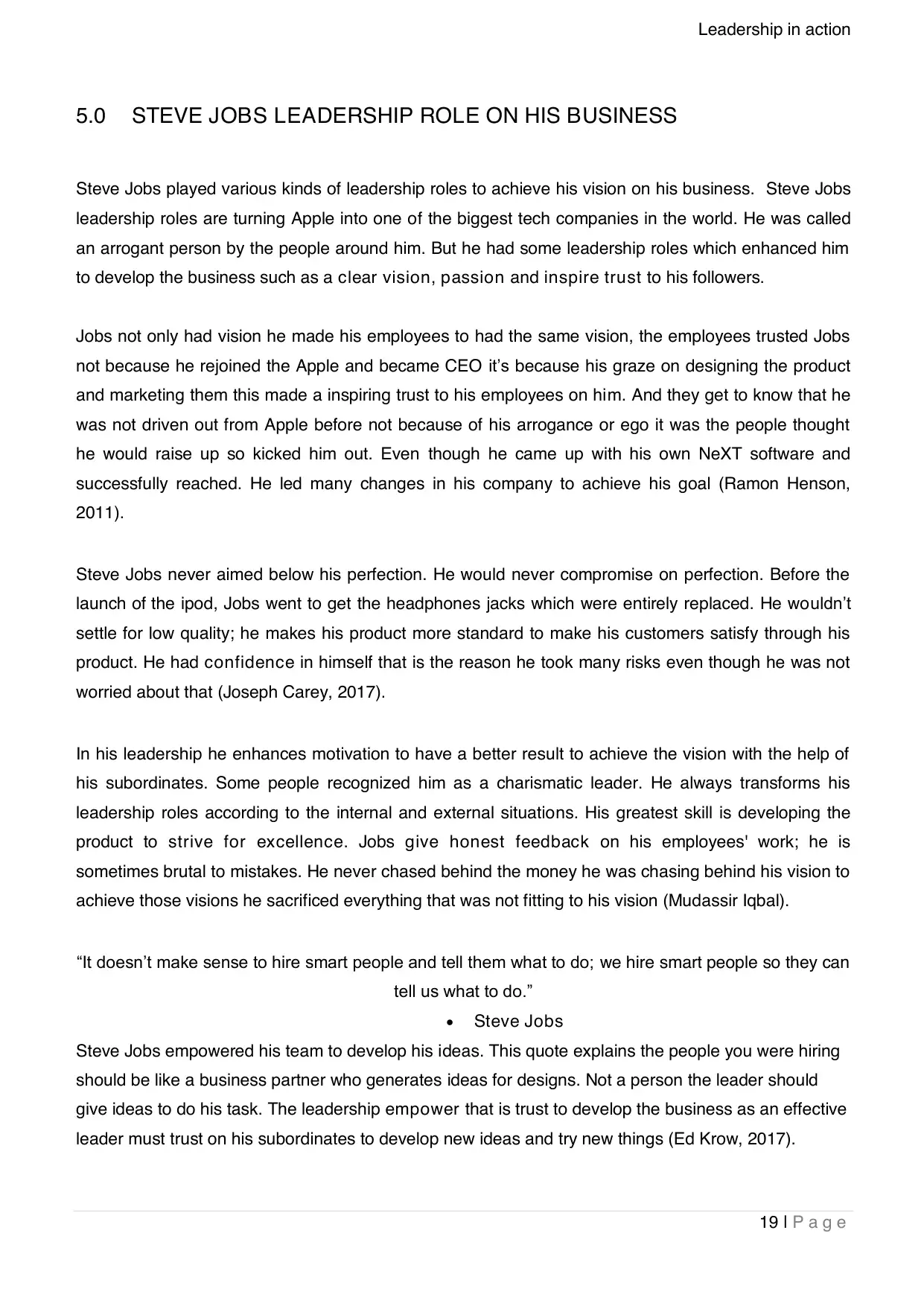
Leadership in action
19 | P a g e
5.0 STEVE JOBS LEADERSHIP ROLE ON HIS BUSINESS
Steve Jobs played various kinds of leadership roles to achieve his vision on his business. Steve Jobs
leadership roles are turning Apple into one of the biggest tech companies in the world. He was called
an arrogant person by the people around him. But he had some leadership roles which enhanced him
to develop the business such as a clear vision, passion and inspire trust to his followers.
Jobs not only had vision he made his employees to had the same vision, the employees trusted Jobs
not because he rejoined the Apple and became CEO it’s because his graze on designing the product
and marketing them this made a inspiring trust to his employees on him. And they get to know that he
was not driven out from Apple before not because of his arrogance or ego it was the people thought
he would raise up so kicked him out. Even though he came up with his own NeXT software and
successfully reached. He led many changes in his company to achieve his goal (Ramon Henson,
2011).
Steve Jobs never aimed below his perfection. He would never compromise on perfection. Before the
launch of the ipod, Jobs went to get the headphones jacks which were entirely replaced. He wouldn’t
settle for low quality; he makes his product more standard to make his customers satisfy through his
product. He had confidence in himself that is the reason he took many risks even though he was not
worried about that (Joseph Carey, 2017).
In his leadership he enhances motivation to have a better result to achieve the vision with the help of
his subordinates. Some people recognized him as a charismatic leader. He always transforms his
leadership roles according to the internal and external situations. His greatest skill is developing the
product to strive for excellence. Jobs give honest feedback on his employees' work; he is
sometimes brutal to mistakes. He never chased behind the money he was chasing behind his vision to
achieve those visions he sacrificed everything that was not fitting to his vision (Mudassir Iqbal).
“It doesn’t make sense to hire smart people and tell them what to do; we hire smart people so they can
tell us what to do.”
Steve Jobs
Steve Jobs empowered his team to develop his ideas. This quote explains the people you were hiring
should be like a business partner who generates ideas for designs. Not a person the leader should
give ideas to do his task. The leadership empower that is trust to develop the business as an effective
leader must trust on his subordinates to develop new ideas and try new things (Ed Krow, 2017).
19 | P a g e
5.0 STEVE JOBS LEADERSHIP ROLE ON HIS BUSINESS
Steve Jobs played various kinds of leadership roles to achieve his vision on his business. Steve Jobs
leadership roles are turning Apple into one of the biggest tech companies in the world. He was called
an arrogant person by the people around him. But he had some leadership roles which enhanced him
to develop the business such as a clear vision, passion and inspire trust to his followers.
Jobs not only had vision he made his employees to had the same vision, the employees trusted Jobs
not because he rejoined the Apple and became CEO it’s because his graze on designing the product
and marketing them this made a inspiring trust to his employees on him. And they get to know that he
was not driven out from Apple before not because of his arrogance or ego it was the people thought
he would raise up so kicked him out. Even though he came up with his own NeXT software and
successfully reached. He led many changes in his company to achieve his goal (Ramon Henson,
2011).
Steve Jobs never aimed below his perfection. He would never compromise on perfection. Before the
launch of the ipod, Jobs went to get the headphones jacks which were entirely replaced. He wouldn’t
settle for low quality; he makes his product more standard to make his customers satisfy through his
product. He had confidence in himself that is the reason he took many risks even though he was not
worried about that (Joseph Carey, 2017).
In his leadership he enhances motivation to have a better result to achieve the vision with the help of
his subordinates. Some people recognized him as a charismatic leader. He always transforms his
leadership roles according to the internal and external situations. His greatest skill is developing the
product to strive for excellence. Jobs give honest feedback on his employees' work; he is
sometimes brutal to mistakes. He never chased behind the money he was chasing behind his vision to
achieve those visions he sacrificed everything that was not fitting to his vision (Mudassir Iqbal).
“It doesn’t make sense to hire smart people and tell them what to do; we hire smart people so they can
tell us what to do.”
Steve Jobs
Steve Jobs empowered his team to develop his ideas. This quote explains the people you were hiring
should be like a business partner who generates ideas for designs. Not a person the leader should
give ideas to do his task. The leadership empower that is trust to develop the business as an effective
leader must trust on his subordinates to develop new ideas and try new things (Ed Krow, 2017).
Paraphrase This Document
Need a fresh take? Get an instant paraphrase of this document with our AI Paraphraser
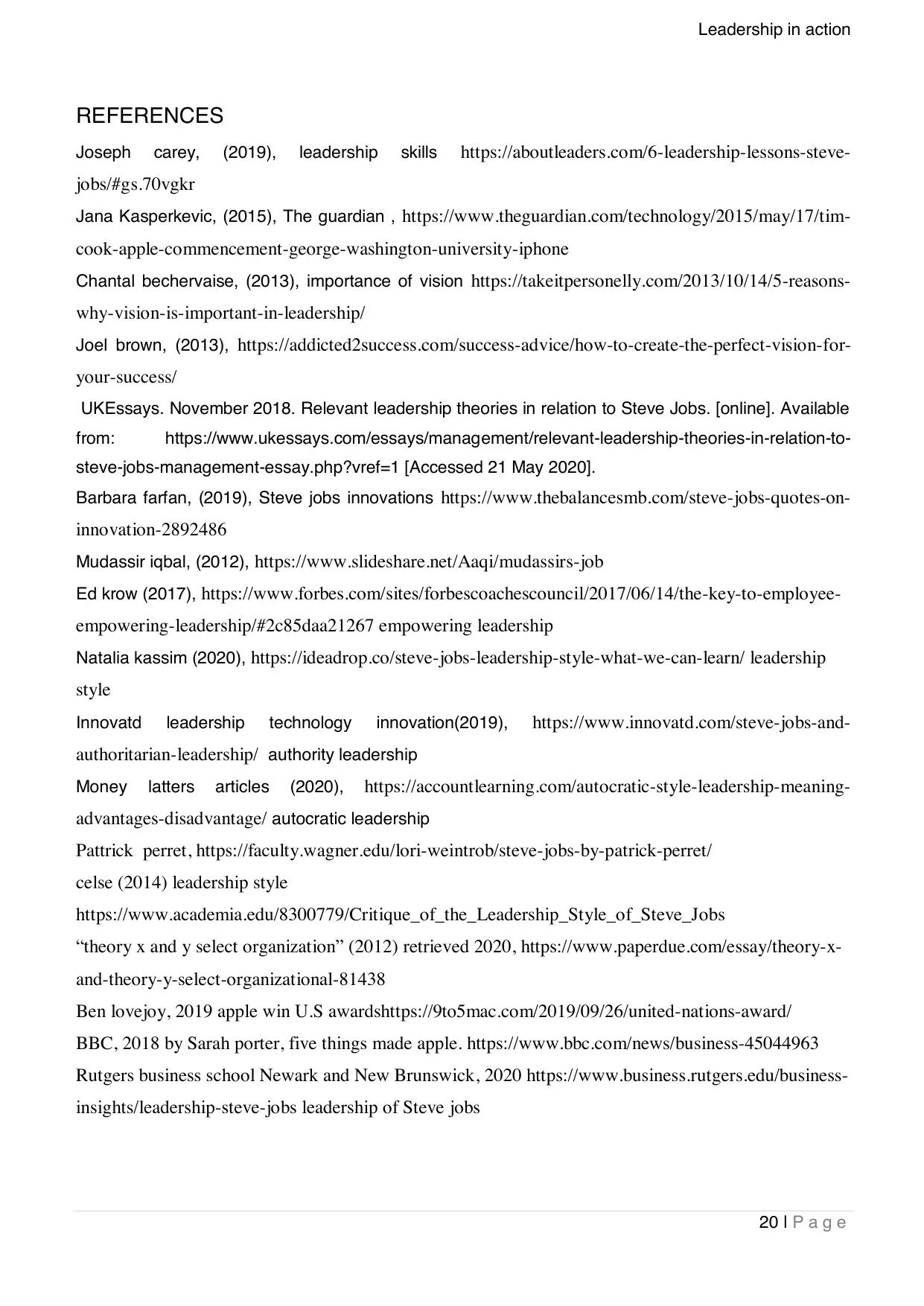
Leadership in action
20 | P a g e
REFERENCES
Joseph carey, (2019), leadership skills https://aboutleaders.com/6-leadership-lessons-steve-
jobs/#gs.70vgkr
Jana Kasperkevic, (2015), The guardian , https://www.theguardian.com/technology/2015/may/17/tim-
cook-apple-commencement-george-washington-university-iphone
Chantal bechervaise, (2013), importance of vision https://takeitpersonelly.com/2013/10/14/5-reasons-
why-vision-is-important-in-leadership/
Joel brown, (2013), https://addicted2success.com/success-advice/how-to-create-the-perfect-vision-for-
your-success/
UKEssays. November 2018. Relevant leadership theories in relation to Steve Jobs. [online]. Available
from: https://www.ukessays.com/essays/management/relevant-leadership-theories-in-relation-to-
steve-jobs-management-essay.php?vref=1 [Accessed 21 May 2020].
Barbara farfan, (2019), Steve jobs innovations https://www.thebalancesmb.com/steve-jobs-quotes-on-
innovation-2892486
Mudassir iqbal, (2012), https://www.slideshare.net/Aaqi/mudassirs-job
Ed krow (2017), https://www.forbes.com/sites/forbescoachescouncil/2017/06/14/the-key-to-employee-
empowering-leadership/#2c85daa21267 empowering leadership
Natalia kassim (2020), https://ideadrop.co/steve-jobs-leadership-style-what-we-can-learn/ leadership
style
Innovatd leadership technology innovation(2019), https://www.innovatd.com/steve-jobs-and-
authoritarian-leadership/ authority leadership
Money latters articles (2020), https://accountlearning.com/autocratic-style-leadership-meaning-
advantages-disadvantage/ autocratic leadership
Pattrick perret, https://faculty.wagner.edu/lori-weintrob/steve-jobs-by-patrick-perret/
celse (2014) leadership style
https://www.academia.edu/8300779/Critique_of_the_Leadership_Style_of_Steve_Jobs
“theory x and y select organization” (2012) retrieved 2020, https://www.paperdue.com/essay/theory-x-
and-theory-y-select-organizational-81438
Ben lovejoy, 2019 apple win U.S awardshttps://9to5mac.com/2019/09/26/united-nations-award/
BBC, 2018 by Sarah porter, five things made apple. https://www.bbc.com/news/business-45044963
Rutgers business school Newark and New Brunswick, 2020 https://www.business.rutgers.edu/business-
insights/leadership-steve-jobs leadership of Steve jobs
20 | P a g e
REFERENCES
Joseph carey, (2019), leadership skills https://aboutleaders.com/6-leadership-lessons-steve-
jobs/#gs.70vgkr
Jana Kasperkevic, (2015), The guardian , https://www.theguardian.com/technology/2015/may/17/tim-
cook-apple-commencement-george-washington-university-iphone
Chantal bechervaise, (2013), importance of vision https://takeitpersonelly.com/2013/10/14/5-reasons-
why-vision-is-important-in-leadership/
Joel brown, (2013), https://addicted2success.com/success-advice/how-to-create-the-perfect-vision-for-
your-success/
UKEssays. November 2018. Relevant leadership theories in relation to Steve Jobs. [online]. Available
from: https://www.ukessays.com/essays/management/relevant-leadership-theories-in-relation-to-
steve-jobs-management-essay.php?vref=1 [Accessed 21 May 2020].
Barbara farfan, (2019), Steve jobs innovations https://www.thebalancesmb.com/steve-jobs-quotes-on-
innovation-2892486
Mudassir iqbal, (2012), https://www.slideshare.net/Aaqi/mudassirs-job
Ed krow (2017), https://www.forbes.com/sites/forbescoachescouncil/2017/06/14/the-key-to-employee-
empowering-leadership/#2c85daa21267 empowering leadership
Natalia kassim (2020), https://ideadrop.co/steve-jobs-leadership-style-what-we-can-learn/ leadership
style
Innovatd leadership technology innovation(2019), https://www.innovatd.com/steve-jobs-and-
authoritarian-leadership/ authority leadership
Money latters articles (2020), https://accountlearning.com/autocratic-style-leadership-meaning-
advantages-disadvantage/ autocratic leadership
Pattrick perret, https://faculty.wagner.edu/lori-weintrob/steve-jobs-by-patrick-perret/
celse (2014) leadership style
https://www.academia.edu/8300779/Critique_of_the_Leadership_Style_of_Steve_Jobs
“theory x and y select organization” (2012) retrieved 2020, https://www.paperdue.com/essay/theory-x-
and-theory-y-select-organizational-81438
Ben lovejoy, 2019 apple win U.S awardshttps://9to5mac.com/2019/09/26/united-nations-award/
BBC, 2018 by Sarah porter, five things made apple. https://www.bbc.com/news/business-45044963
Rutgers business school Newark and New Brunswick, 2020 https://www.business.rutgers.edu/business-
insights/leadership-steve-jobs leadership of Steve jobs
1 out of 20
Related Documents
Your All-in-One AI-Powered Toolkit for Academic Success.
+13062052269
info@desklib.com
Available 24*7 on WhatsApp / Email
![[object Object]](/_next/static/media/star-bottom.7253800d.svg)
Unlock your academic potential
© 2024 | Zucol Services PVT LTD | All rights reserved.





